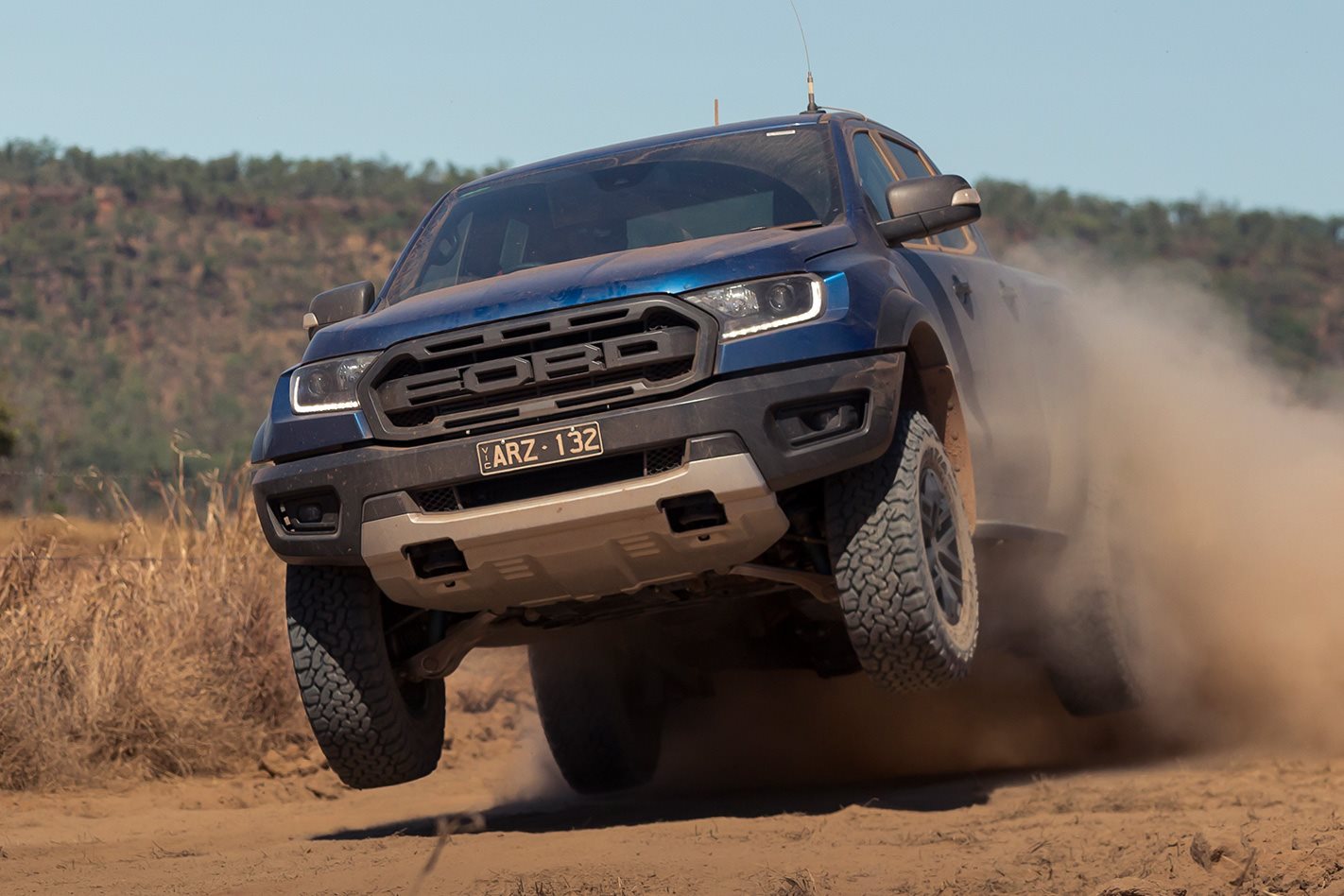- Wheels first drive review
- Wheels Spin: Should we buy it?
- 4×4 Australia first drive review
- 4×4 Australia road trip feature review
Wheels first drive review
WHAT IS IT
The Raptor mines a new vein in the gold rush that is the Australian dual-cab ute market, namely that of the Baja-style desert racer. With a 157kW/500Nm 2.0-litre four-cylinder turbo-diesel under the bonnet and long-travel Fox Racing suspension, it’s built to be bulletproof where the bitumen ends.
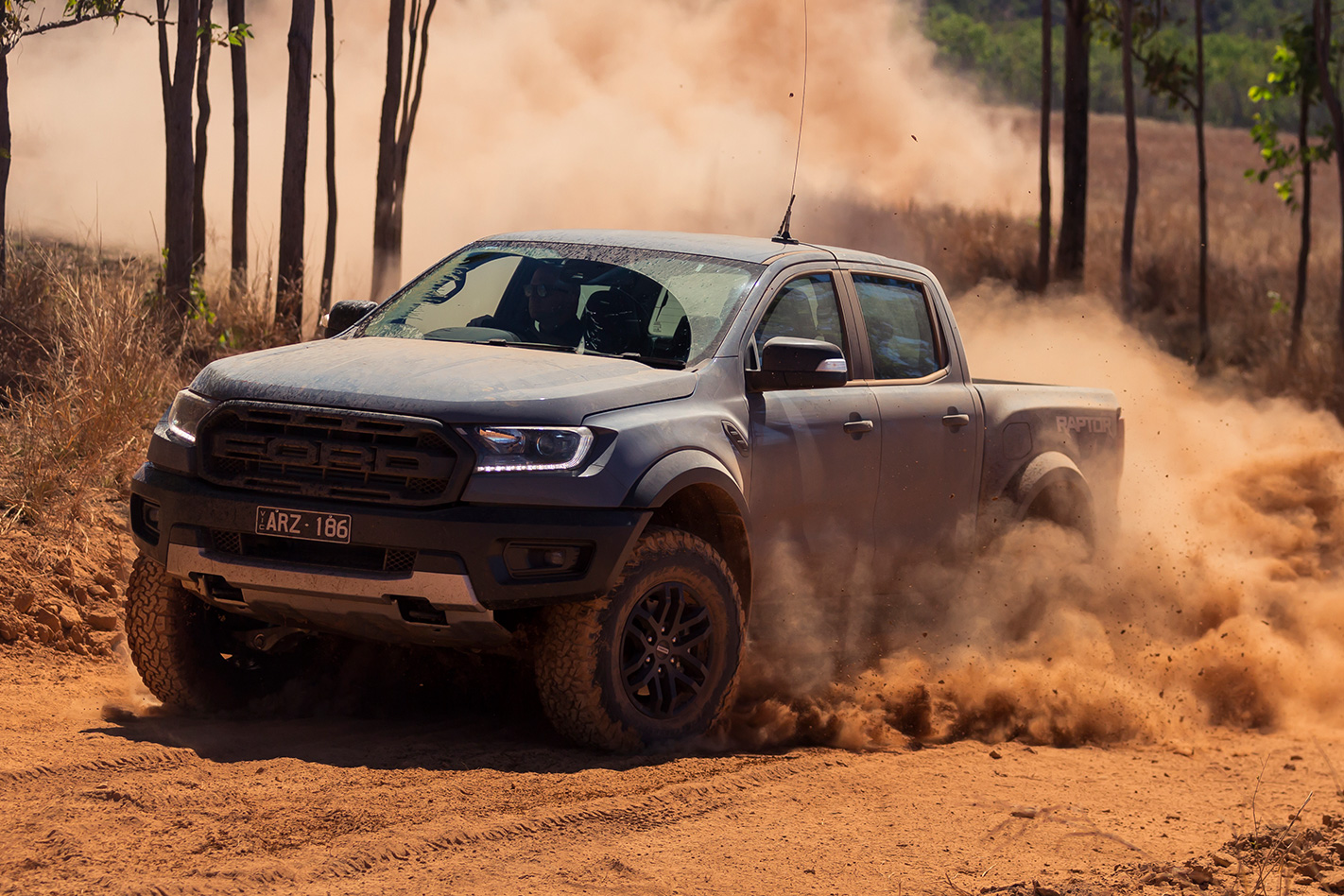
WHY WE’RE TESTING IT
It’s one of the most controversial/hotly anticipated (delete as applicable) vehicles of 2018, so we jumped at the chance of giving the Ford Ranger Raptor a solid battering in the uncompromising NT. Some big questions needed answering, the most obvious being whether a dinky 2.0-litre diesel was enough engine for a ute with such hardcore pretensions.
MAIN RIVALS
Holden Colorado SportsCat+ by HSV; Mercedes-Benz X350; Volkswagen Amarok V6
THE WHEELS VERDICT
The Ford Ranger Raptor offers a whole heap of fun and capability for $75K, but makes most sense if you have the off-road acreage upon which to unleash it. The 2.0-litre lump can feel a little underdone on bitumen, although the fantastic Fox Racing dampers delivers supreme ride quality whatever the surface. It’s probably more ‘specialist interest’ than its order books might suggest, but it’s nevertheless both endearing and engaging.
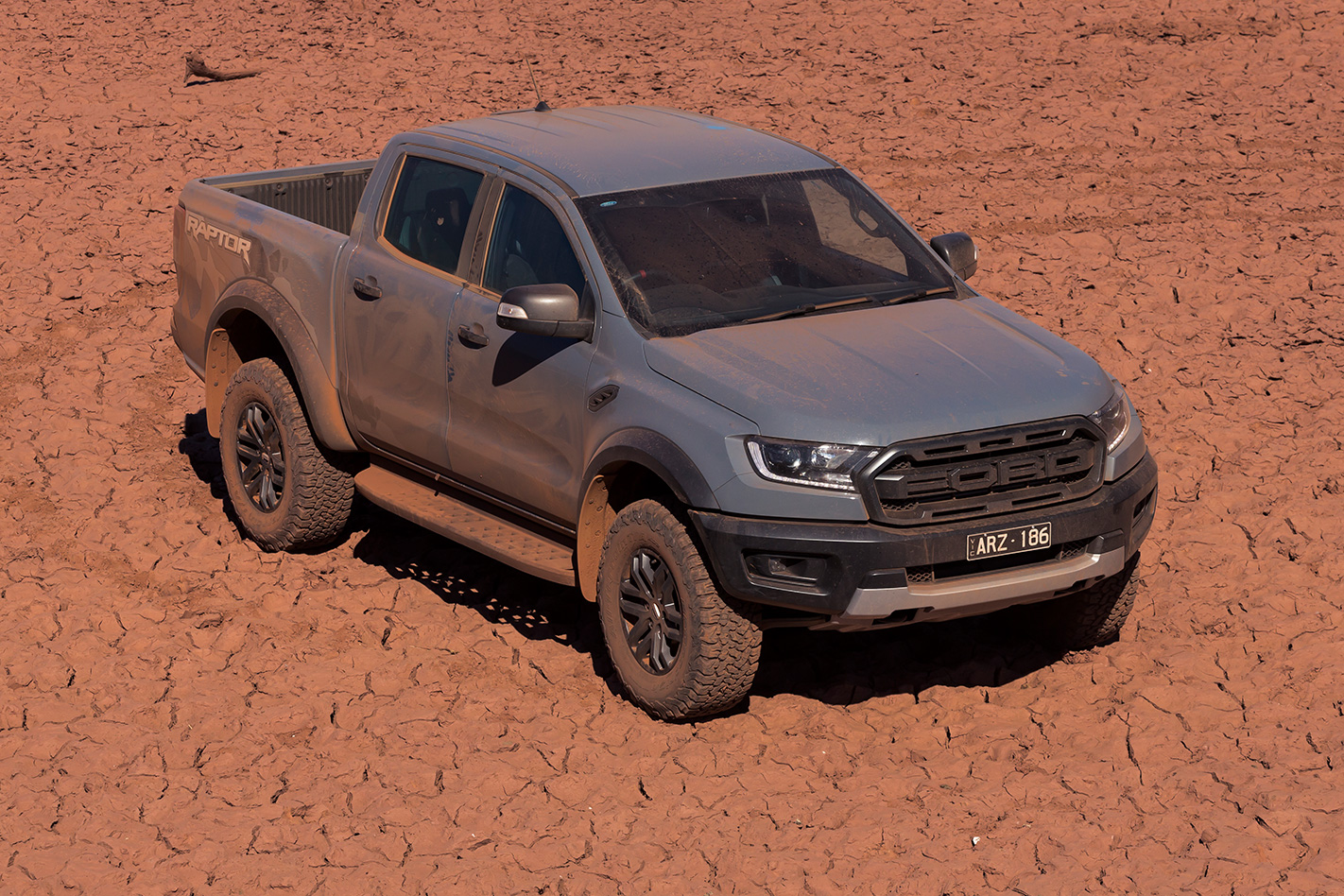
PLUS: Class-leading suspension; butch styling; clever off-road electronics; decent transmission MINUS: Not particularly quick; no AEB; peaky torque delivery
THE WHEELS REVIEW
BY NOW, you’ll probably know all the basics of Ford’s Ranger Raptor, so we don’t need to go over them in too much detail. In summary, you get a Ranger that’s been substantially re-engineered with Baja-style Fox long-travel suspension, a toughened chassis, a ten-speed automatic and, up front, a 2.0-litre turbo-diesel lump good for 157kW and 500Nm. Read the marketing spiel and you’d be forgiven for thinking that this is the most hairy-chested thing to sport a four-pot this side of a Porsche 919.
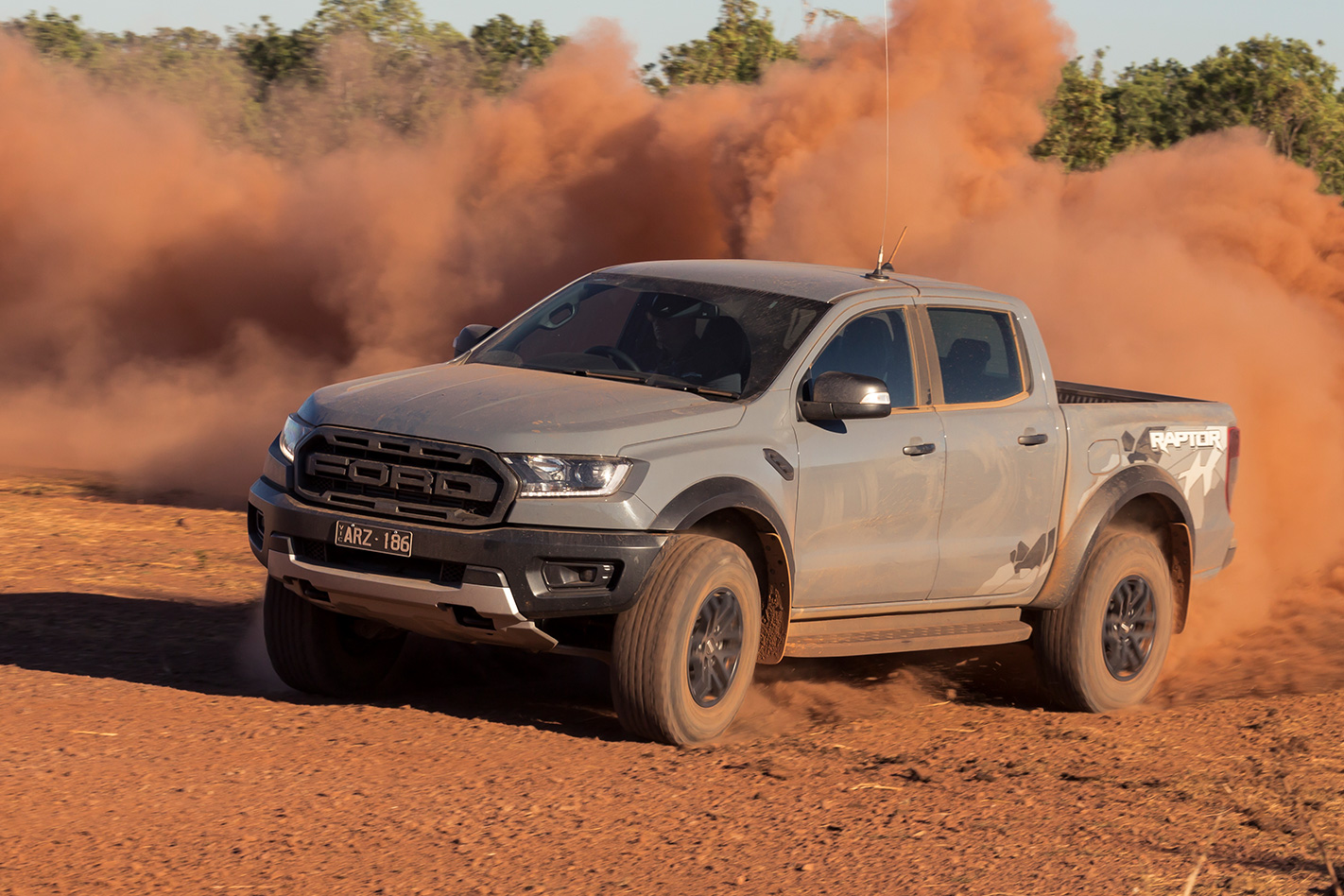
As intrigued as we were at the prospect of this vehicle, it raised three fairly fundamental issues. Does it have enough engine, can it live up to its hype off-road and, finally, is it worth the $75,000 asking price? We took the opportunity to give the Raptor a fairly unrestricted leathering in a 4000km2 cattle station in the Northern Territory in order to answer these questions.
The easiest to answer is whether it can cut the mustard off-road. The key to its competence is the combination of the Fox dampers and the 285/70R17 BF Goodrich KO2 tyre which in concert deliver a long-travel plushness to the ride and decent lateral grip on loose surfaces. The tyre is particularly interesting, having been developed specifically for the car with an S (180km/h) rating and the ability to find purchase on the loose without imposing too much of a noise penalty on bitumen. The pillow-top ride quality on road is teamed with relaxed but well-judged pitch and roll resistance.
Raptor’s Fox shocks went through 42 prototype iterations at the front and 74 at the rear before the final valve and shim combination was decided upon
Off-road, the rebound damping is particularly impressive, the Raptor able to be launched over small yumps, whoops and drop-offs without the suspension crashing. Even when driven hard into compressions that would fold a garden variety Ranger in half, the Raptor swallows horrific hits without troubling its bump stops. It’s uncanny. “The shocks act much like a soft-close drawer,” says Simon Johnson, vehicle dynamics lead on the Raptor programme. “No matter how hard you slam the drawer, it’ll always slow and catch it.”
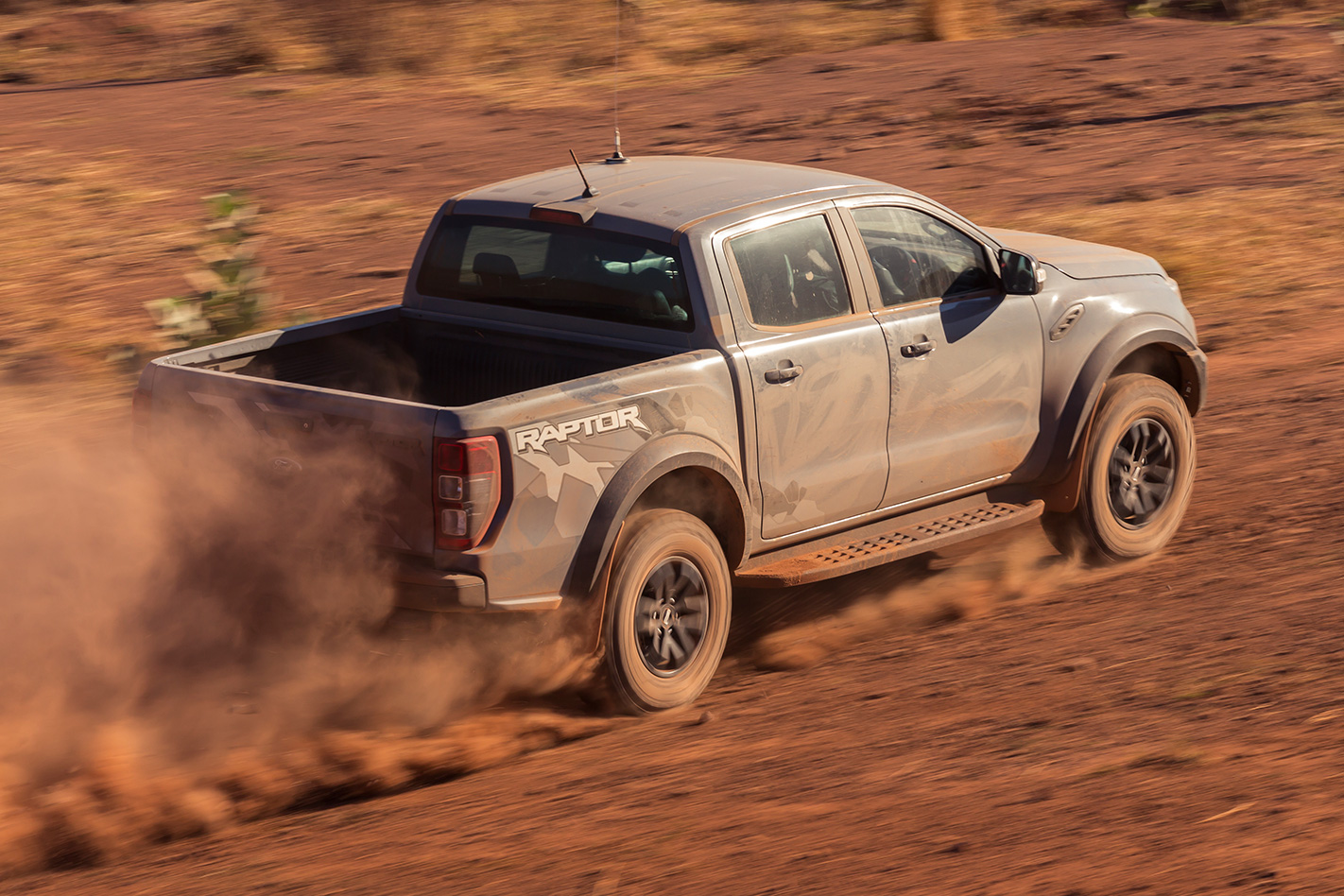
Other off-road features include hill descent control that is tuneable for speed either by the cruise control buttons or via the throttle or brake pedal. The raised ride height of 283mm – up 50mm on the standard Ranger – and a track widened by 150mm give the Raptor a beefy, foursquare stance with approach, breakover and departure angles of 32.5, 24 and 24 degrees respectively. A low range transfer case and a centre diff lock means you’ll have to try pretty hard to get one of these stuck. Should you excel yourself, 3.8-tonne rated tow hooks front and rear will help you out of a spot. It’s worth considering that while other Rangers get the option of autonomous emergency braking, the Raptor doesn’t; at least until next year. A senior Ford source told us that this was due to technical issues with sensor positioning and the occurrence of unwanted AEB interventions when running on broken terrain off road. For the first wave of vehicles, AEB will not be available, but later in 2019, Ford will have an autonomous braking solution ready to ship.
Aussie Raptors are Euro5 compliant rather than the 6.1 spec cars that Euro markets get. At least that means we don’t have to bother with AdBlue top-ups
What’s perhaps most impressive about the Raptor’s off-road chops is the Terrain Management System’s Baja mode, which allows 20 degrees or so of yaw with ESC on, giving the off-road driver the option of oversteering the Ranger into a corner on the brakes to get the nose pointed in vaguely the right direction whilst still retaining the safety net of some stability control should you really get a bit ambitious. Available in both front and rear drive settings, Baja mode does particularly interesting things to the electrically-assisted steering, damping the response slightly which would be undesirable on bitumen, but on the loose allows you to wind on lock without making the front end nervous or pointy-feeling. Likewise, it softens the throttle pedal mapping slightly so as not to tip the vehicle into unwanted traction control interventions and holds onto gears for a bit longer.
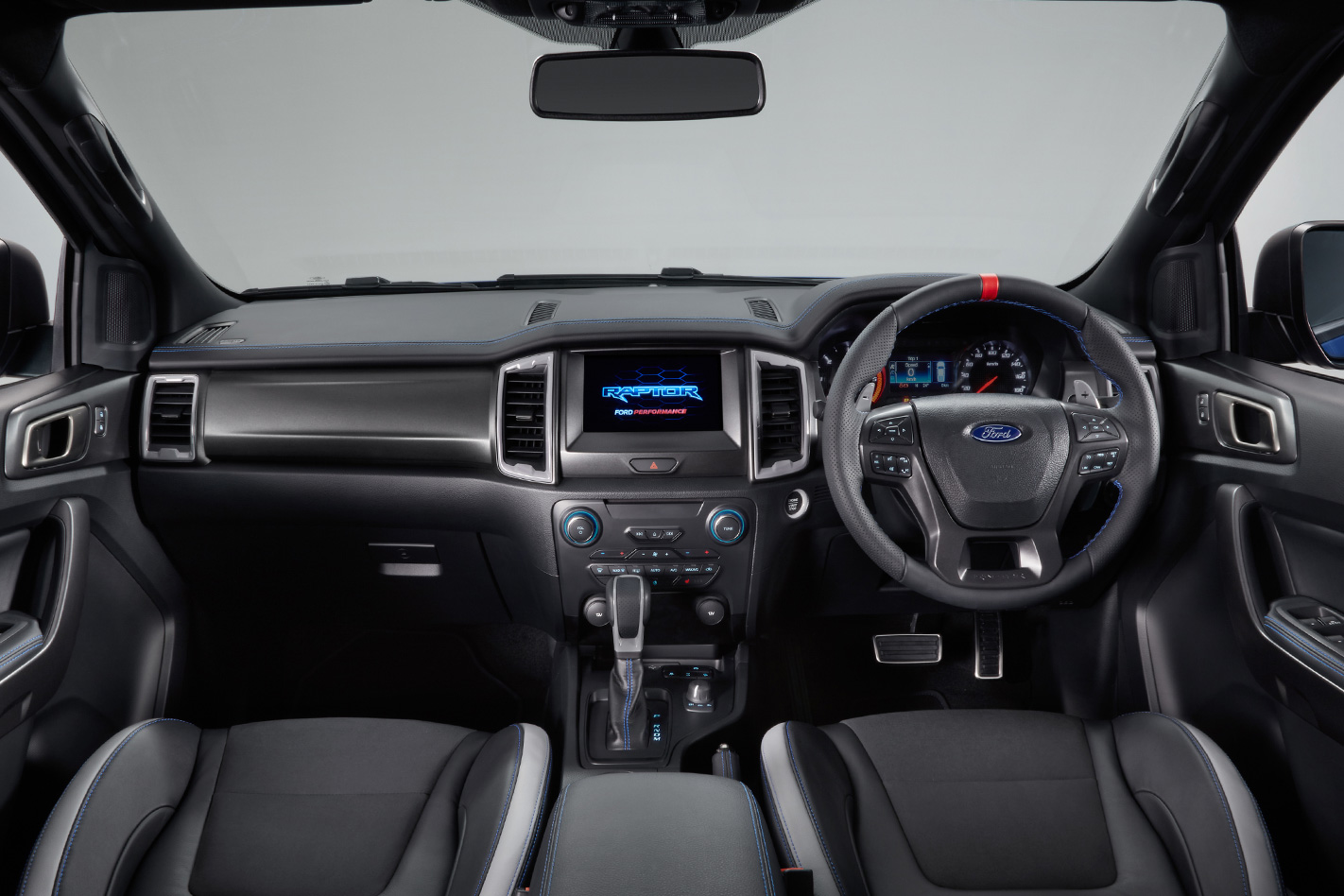
So while the Raptor lives up to its engineering claims off-road, on blacktop it’s not quite such an unblemished scorecard. There’s no real way of sugar-coating the fact that this is a $75K Ford Performance product that has a power to weight ratio of 65kW per tonne. That’s only a gnat’s better than an entry-level VW Polo 70TSI. Little wonder that 100km/h comes and goes in a stately 10.5 seconds. In other words, don’t try to challenge a V6 Amarok or X-Class away from the lights.
Raptor’s tray measures 1560mm x 1743mm and towing capacity is rated at 2500kg
Drive it solely off-road and you’ll find it more than adequate. On road, it can feel a little anaemic, although the 10-speed automatic transmission does try to wring the best of it out. The fact that peak torque is maintained across a mere 250rpm between 1750 and 2000rpm coupled with shift paddles that seem to deny downshifts a little too censoriously means that the ‘box is best left in ‘D’ to get on with things. The steering is crisply weighted and the brakes beefed up to cope with the Raptor’s considerable extra weight over a garden-variety Ranger XLT, but that weight further blunts the grunt that is on tap. There’s never that effortless surge of torque you want and expect. We tested a Ranger XLT at 10.1 seconds to 100km/h last month, so the Raptor could well be outdragged by a sibling that’s $18K cheaper. It also proved slower than the Triton Exceed, Amarok, Mercedes X250d, Colorado LTZ and the Navara ST-X we tested in July’s issue of the magazine.
And therein lies the Raptor’s rub. Viewed through the narrow lens of pure function, the engine is fine for its high-speed off-road remit. It’s gutsy enough, wields a 900km+ theoretical range and weighs around 70kg less than the doughty 3.2-litre five. But in focusing almost exclusively on fitness for a largely esoteric purpose, Ford’s engineers have compromised the Raptor for what it will actually be used for. Most Aussie buyers will never experience their vehicle at high speed on dirt or sand, much less launch it off a yump. Those filling Ford’s order bank will get a great looking, sweet riding and benign handling dual-cab that’s one of a kind, but which can appear skewed on the mouth/trousers ratio. Vacation on a cattle station and it’ll all make sense.
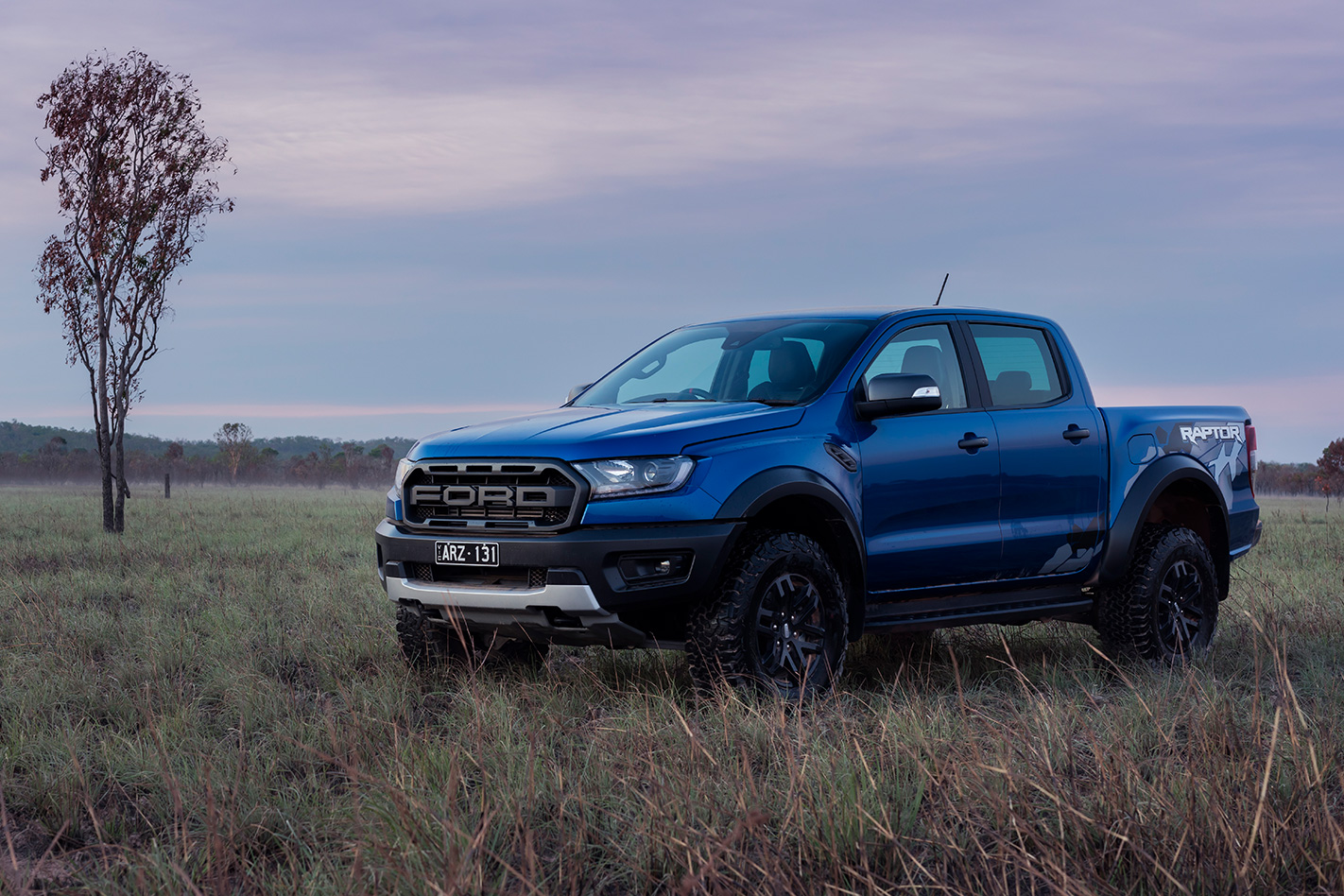
SPECS
Model: Ford Ranger Raptor Engine: 1996cc inline 4cyl, 16v, dohc, turbo diesel Max power: 157kW @ 3750rpm Max torque: 500Nm @ 1750-2000rpm Transmission: 10-speed automatic Weight: 2404kg 0-100km/h: 10.5 sec (claimed) Economy: 8.2L/100km (combined) Price: $74,990 On sale: September 2018
MORE: Ford Ranger Range Review MORE: Ford Ranger Specs, Range & Price
Wheels Spin: Should we buy it?
Short, sharp and to the point, Wheels spin is the quick read you need to get to know a car.

What’s in the garage?
In terms of driveway goals and tradie one-upmanship, the Blue Oval’s Ranger Raptor is high on the ‘want’ list. However, Ford’s offering isn’t merely a sticker pack and a jacked-up price. Genuine off-road cred materialises in the form of Fox 2.5-inch bypass shock absorbers and 285/70 R17 BFGoodrich tyres with bush-bashing tread to fill the pumped guards. There’s 150mm more track front to rear, an extra 46mm of ground clearance and 30 percent more suspension travel to fulfil your stadium-truck dreams. The sticking point at launch was the lack of an EcoBoost V6 powertrain – a quoted 0-100km/h time of 10.5 seconds isn’t earth shattering. However, the 2.0-litre bi-turbo diesel four-cylinder offers 157kW and a substantial 500Nm of pulling power. Tied to Ford’s new 10-speed automatic (with paddle shifters) and a trick driving mode branded Baja, the Raptor has the gear to back up its dominating presence. If you want one, you’ll need to stump up $74,990.
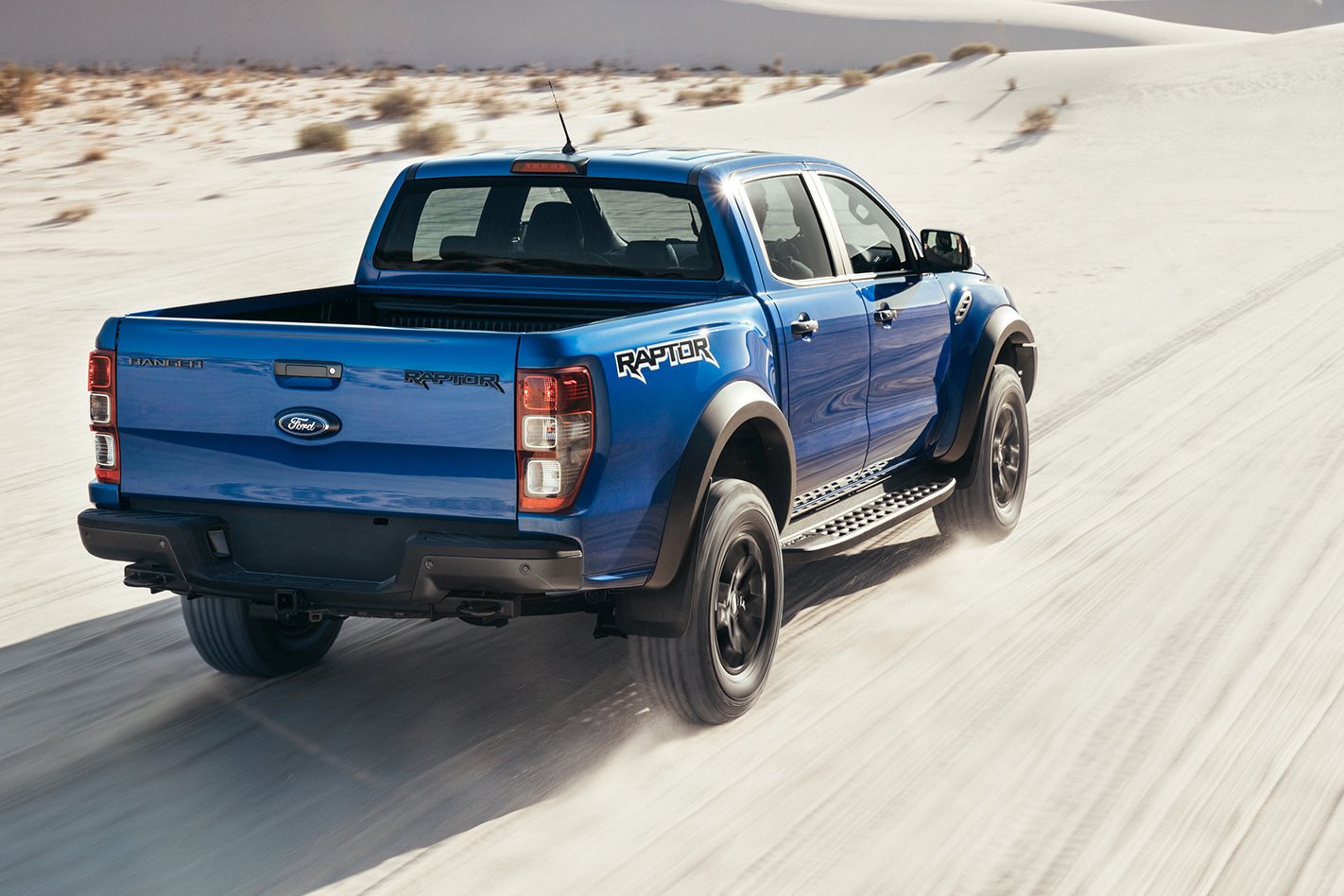
What we reckon
Why should you pay the extra cash for a Raptor over a Wildtrak I hear you ask? Simply, it is all about that suspension, which is a revolution for those who daily drive a dual-cab in an urban environment. While the marketing people would have you believe that this ute is all about off-road antics, its secret weapon is how liveable it is in the inner-city. The 2.0-litre unit is one of the more refined engines in the segment, the 10-speed smooth and well-calibrated, while the beefed-up suspension is beautifully compliant on road, and banishes the unladen jiggle that haunts all other dual-cabs.
If you dream of something that’s actually capable and will make you smile, the Ranger Raptor is the ‘truck’ of choice. Thanks to the Fox hardware underneath, the ride quality surpasses other dual cabs and you can launch it at any urban-jungle speedbump at pace, which spices up the daily commute. The BFGoodrich hoops don’t offer much grip in the wet (especially in two-wheel drive) and the auto can go in search of power that isn’t there, but overall the Raptor is as polished as it needs to be. I doubt any buyer will be disappointed.
The ride and handling of the Raptor is supreme in the dual-cab market, both on and off the road. Even if you were to buy a Ranger XLT, or a rival, and throw thousands at changing the factory-tuned suspension you still wouldn’t match the ride compliance found here. It’s utterly impressive off-road, where it unravels bumps and lumps from unsettling the chassis at speed and gives a huge ground-clearance with lots of grip for tackling serious four-wheel-drive tracks. It’s also easy to live with around town, and the diesel donk, though I was initially sceptical, is effortless and refined with the 10-speed auto behind it. If I had the money for a ute, this would be the one.
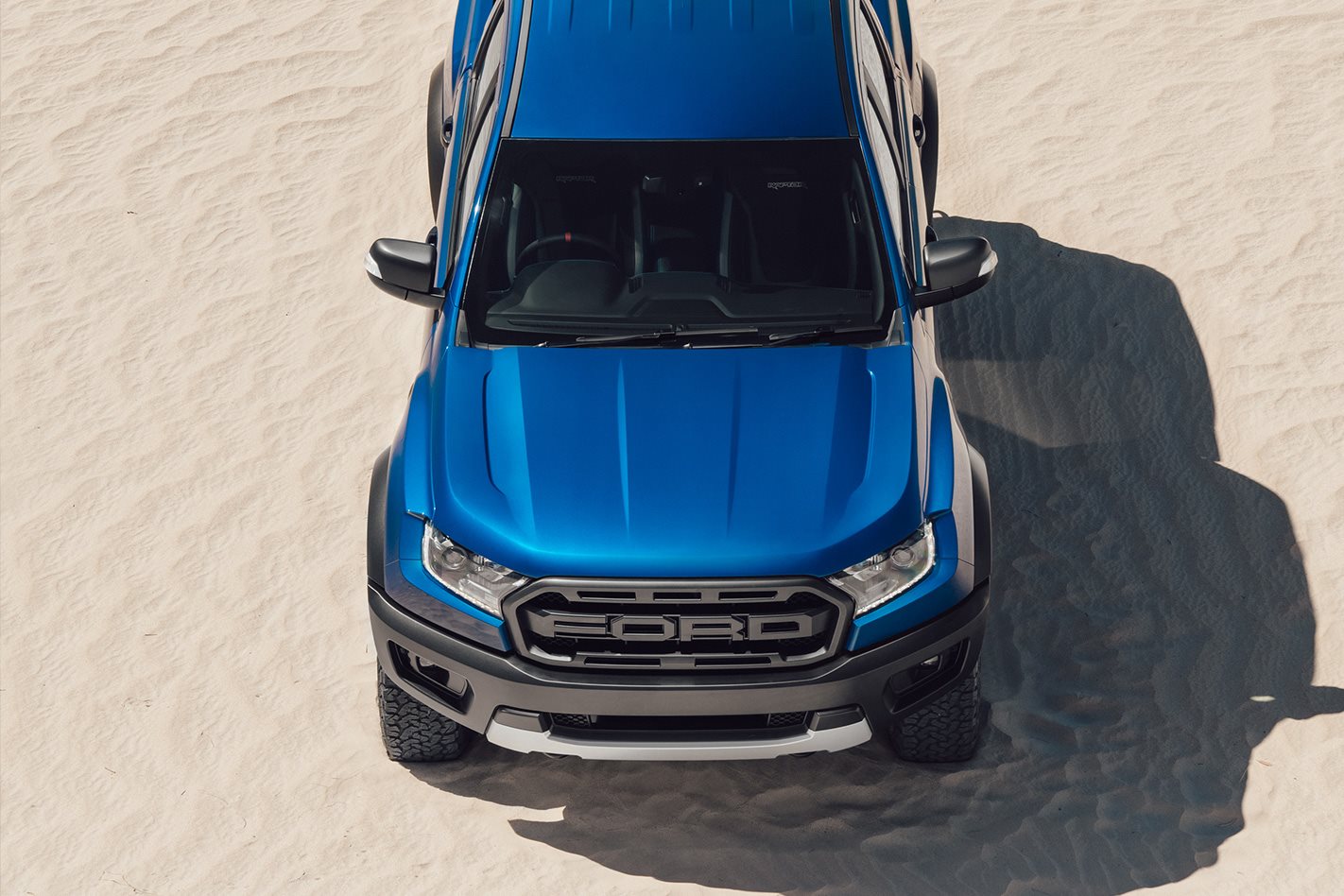
Review
Power and performance:
If you’re expecting the Ranger Raptor to match its outward menace in straight-line pace you’ll be largely disappointed. Just like its competition, Ford’s offering is all about torque over outright performance. And it delivers that in spades. The new, downsized 2.0-litre four-cylinder bi-turbo unit is a more refined unit over the outgoing single turbo five-pot, behaving much more like a passenger-vehicle-spec diesel over a commercial unit. With 500Nm of grunt, there’s certainly no shortage of torque to pull you out of trouble or to cruise in higher gears with the largely slick 10-speed auto. If towing is a high priority, opting for the ‘old’ 3.2-litre, six-speed auto combo would be a better bet. It’s also a shame we don’t have the option of the 2.3-litre EcoBoost petrol four-cylinder that’s standard in the US. Still, despite the fact there’s no boosted V6 nestled within the engine bay, the 2.0-litre oiler is an impressive engine that endows the Raptor with enough bite to get stuck in off-road.
Ride and handling:
Sitting on Ford’s T6 modular chassis, designed to allow for different wheelbases and suspension setups, the rugged Ranger has been extensively modified for extra stability. In terms of ride quality, the Raptor is a revelation – both on- and off-road. Ford has spent money on expensive Fox Racing dampers, and they work wonders for city potholes and any obstacle you might encounter out of urban gridlock. Its ability to absorb and control rebound movement is truly staggering. The regular coils at the back have also been replaced with a Watts linkage, adding genuine long-haul ability to the Ranger. Six driving modes are offered, with the key one aptly-named ‘Baja’, which sharpens the auto’s actions and allows a little more freedom from the electronic aids to have some fun in the dirt. It’s still a hardcore 4×4, meaning a dual-range transfer case is fitted, the wading depth is 850mm and there’s 283mm of ground clearance to play with. The Raptor will conquer just about anything, but watch out for wet tarmac as the BFGoodrich tyres don’t offer optimal grip – especially in two-wheel drive mode.
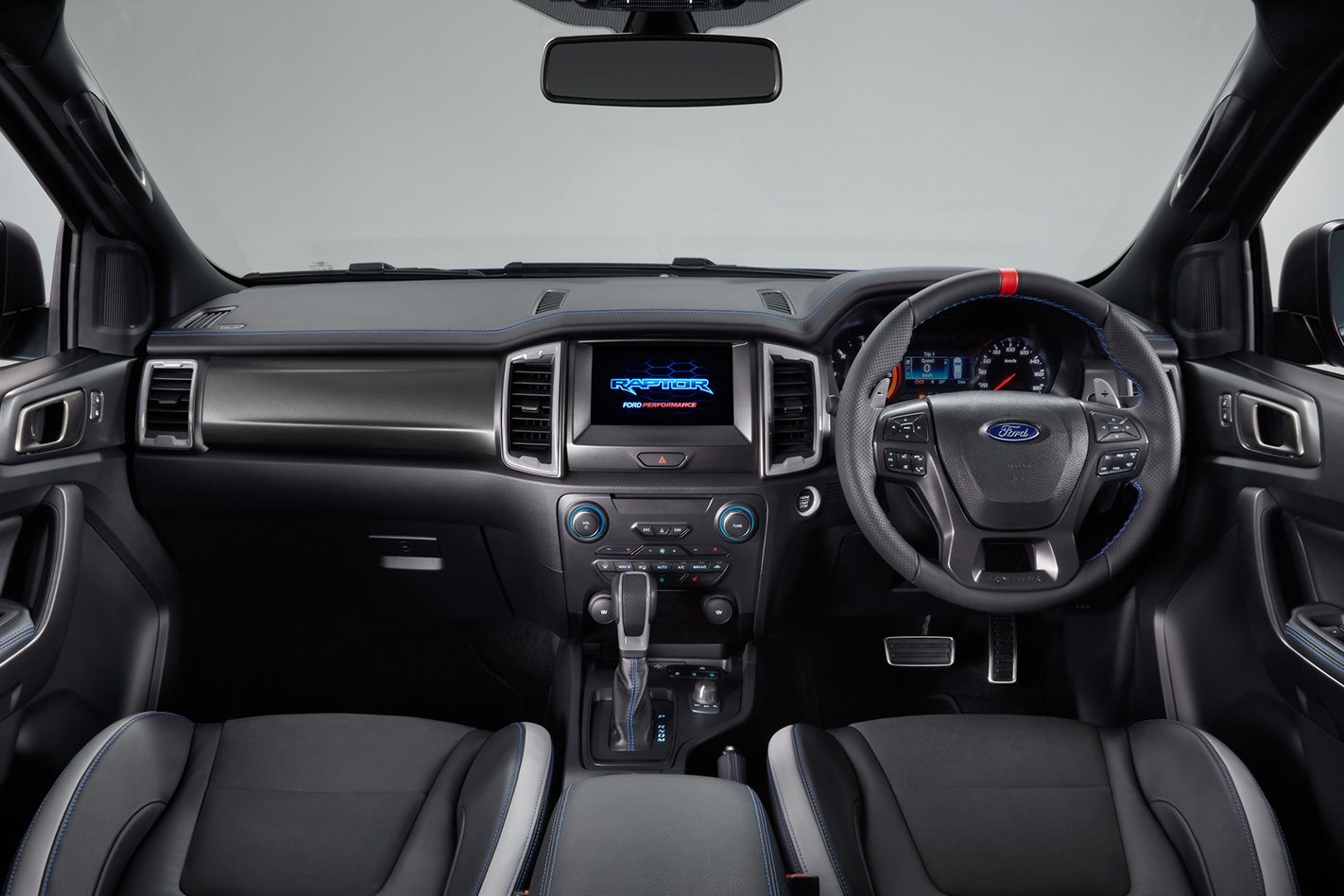
Interior and Comfort:
It’s a Ranger… and despite its halo-status, it looks like one inside, too. Yes, you get some Ford Performance badging, steering wheel-mounted paddle shifters, a leather-wrapped steering wheel, gear shifter and handbrake and well as unique seat trim, but it’s not too dissimilar from the rest of the higher model grades. Infotainment is covered off with Ford’s SYNC 3 system as well as the capacity to provide Apple CarPlay and Android Auto functionality via the central 8.0-inch touchscreen. The Raptor also scores AEB, lane keeping and departure warning, trailer sway control and all-round sensors as some of the standard safety tech. The dimensions of the cargo tub are the same as the garden-variety Raptor, so all the usual accessories will fit. However, the overall towing capacity is down 1 tonne to 2500kg and the payload is reduced to 758kg.
Verdict
If you’re in the market for a dual cab that’s genuinely capable and looks the part, then the Ranger Raptor isn’t going to be a disappointment. At $74,990 it’s a premium product, but you have to factor in the expensive hardware underneath helping the Raptor be as skilled as it is. And you can’t discount the fact that the Raptor is as competent as it is fun.
Second opinion: 4×4 Australia first drive review

4X4: Australia’s guide to the off-road adventure lifestyle.
Mixing in-depth vehicle reviews with off-the-beaten-track adventures and gear tests, 4X4 is all about enjoying Australia’s great outdoors.
Ford applied the Raptor treatment to the Ranger pick-up, but does it deliver the performance buyers want? By: Matt Raudonikis

THE modern dual-cab ute is designed to fulfill so many roles, yet it never really masters any of them. It needs to be a work truck, family transporter, a touring explorer, a tow tug and an off-road adventure machine, but by trying to meet all of these demands it is always compromised.
As 4×4 enthusiasts we modify and customise our vehicles to better meet our intended uses. Tyres, suspension, bar work and custom trays are just some of the many things we change to make the vehicle more focused on what we want out of it.
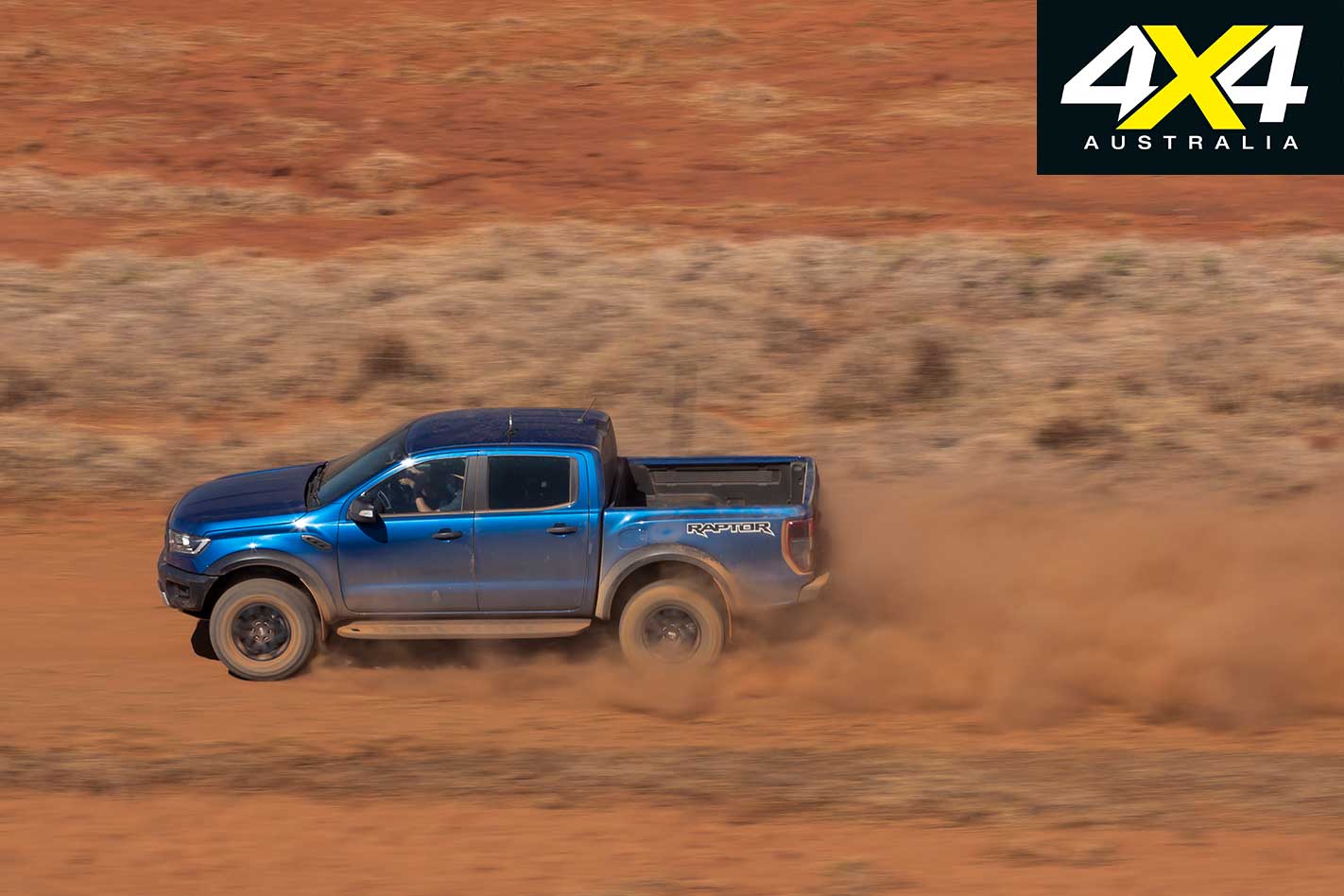
More and more often we hear the term ‘sports ute’ bandied around, and with its F-150 Raptor pick-up in the USA Ford Performance created the ultimate production off-road performance truck.
However, Ford doesn’t offer the F-150 in right-hand drive, so we don’t officially get it in Australia in any form. Our most popular 4×4 pick-up is the Australian designed and developed Ford Ranger, a truck that is a size smaller than the F-Truck yet similarly serves many purposes.
Ford saw the potential of a performance version of its Ranger, and the Australian team has worked with Ford Performance globally to create the Ranger Raptor. A little brother to the F-150 Raptor, the Ranger Raptor carries the same DNA that makes the F-150 so popular but on a smaller scale.
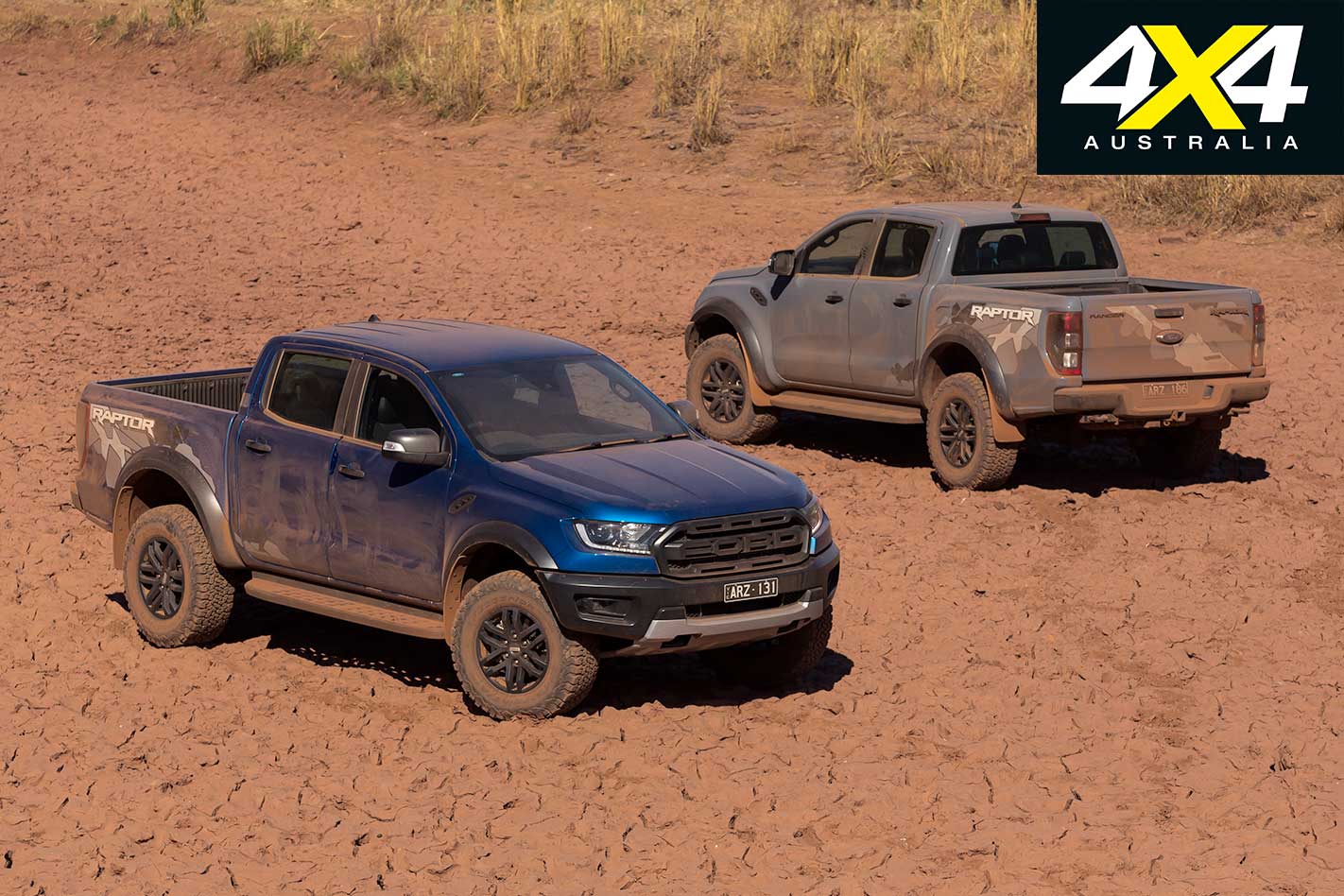
When Ford Performance talks about a ‘performance’ pick up, it’s not just about straight-line grunt. Despite its menacing looks, there’s no stonking, great V8 engine in its Ranger Raptor – or in the F-150 Raptor either, for that matter – it’s more about a total performance package, from the tyres to the bespoke bodywork and sports seats.
Raptor takes its design brief from the pre-runner vehicles used to reconnoiter off-road races such as the famous Baja 1000 in Mexico. For these vehicles, outright pace isn’t the ultimate goal; it’s more about covering the most demanding terrain swiftly, relatively comfortably and safely. Try and do this in any regular truck and it will fall apart around you as you bounce about inside the cabin.
The key components are high-quality suspension and tyres, and the Raptor uses some of the best in the business. While the off-road racers and pre-runners use suspension costing upwards of $5000 per corner from companies like Fox Racing, the production Raptors – Ranger and F-150 – use Fox products.
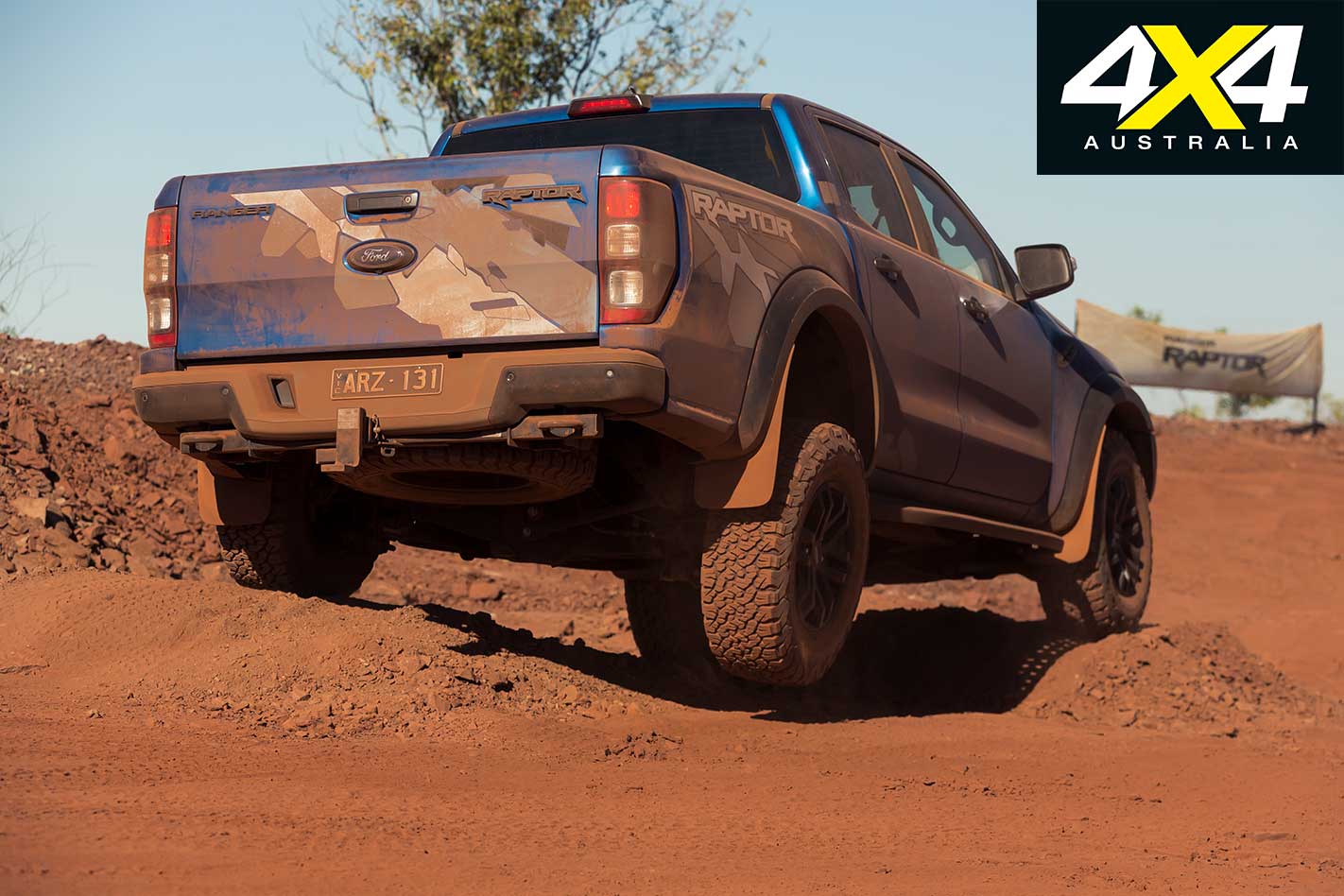
There are designed to be as long-lasting and durable as an OE product, maintain OE standards and ride quality, and still tackle the toughest tracks at speed.
The 2.5-inch bypass shock absorbers used in the Ranger Raptor use race technology and design but are fitted in the smaller package to run in the stock locations. Put simply, a bypass shock has different characteristics in the one unit, depending on the amount of travel.
When the shock is operating in its regular compression area it is able to give a soft and compliant ride, but as the piston inside it moves down, more oil inside the shocks passes through the piston to make it stiffer and able to handle bigger, faster bumps and jumps.
That’s in the simplest of terms, but the Fox shocks and spring package that was specifically developed for the Ranger Raptor allows it to ride over bumps like no other off-the-showroom-floor 4×4.
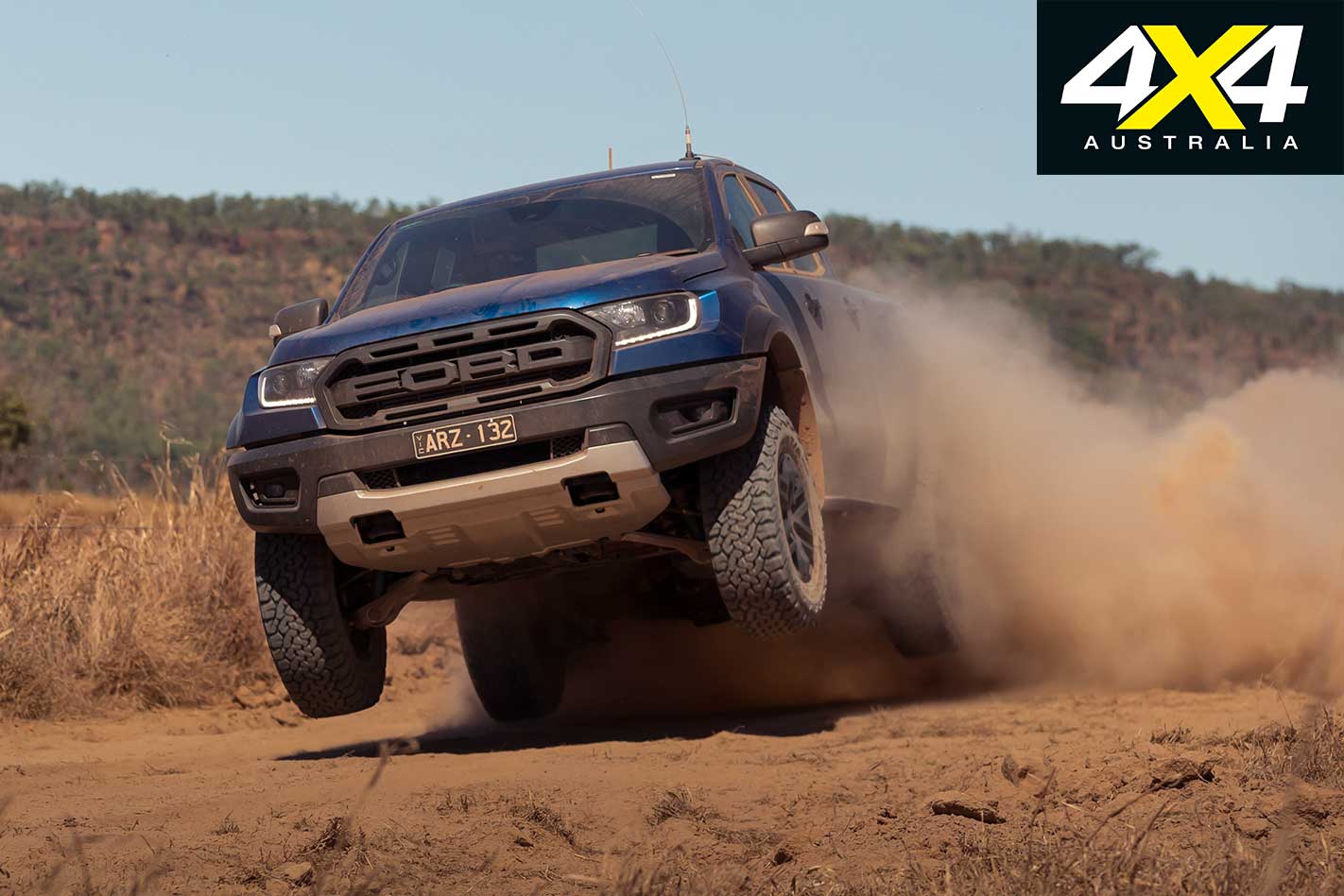
The Fox components bolt into a suspension that increases the Raptor’s wheel track by 150mm over that of a standard Ranger ute, and this added width adds to the vehicle’s stability.
To achieve the extra width, bespoke aluminium A-arms are used on the independent front suspension; while at the rear of the chassis the leaf-sprung live axle of the regular Ranger is replaced by coils with a Watts linkage for lateral support, derived from that on the Ford Everest. It differs from the Everest rear end in that the Fox dampers are mounted farther outboard, again to improve vehicle stability and control.
The chassis is a unique mix of Ranger and Everest parts – call it a Ranger with an Everest rear end or a stretched Everest chassis – but the Ford engineers have made the T6 chassis modular to accommodate a range of different suspension configurations and wheelbases.
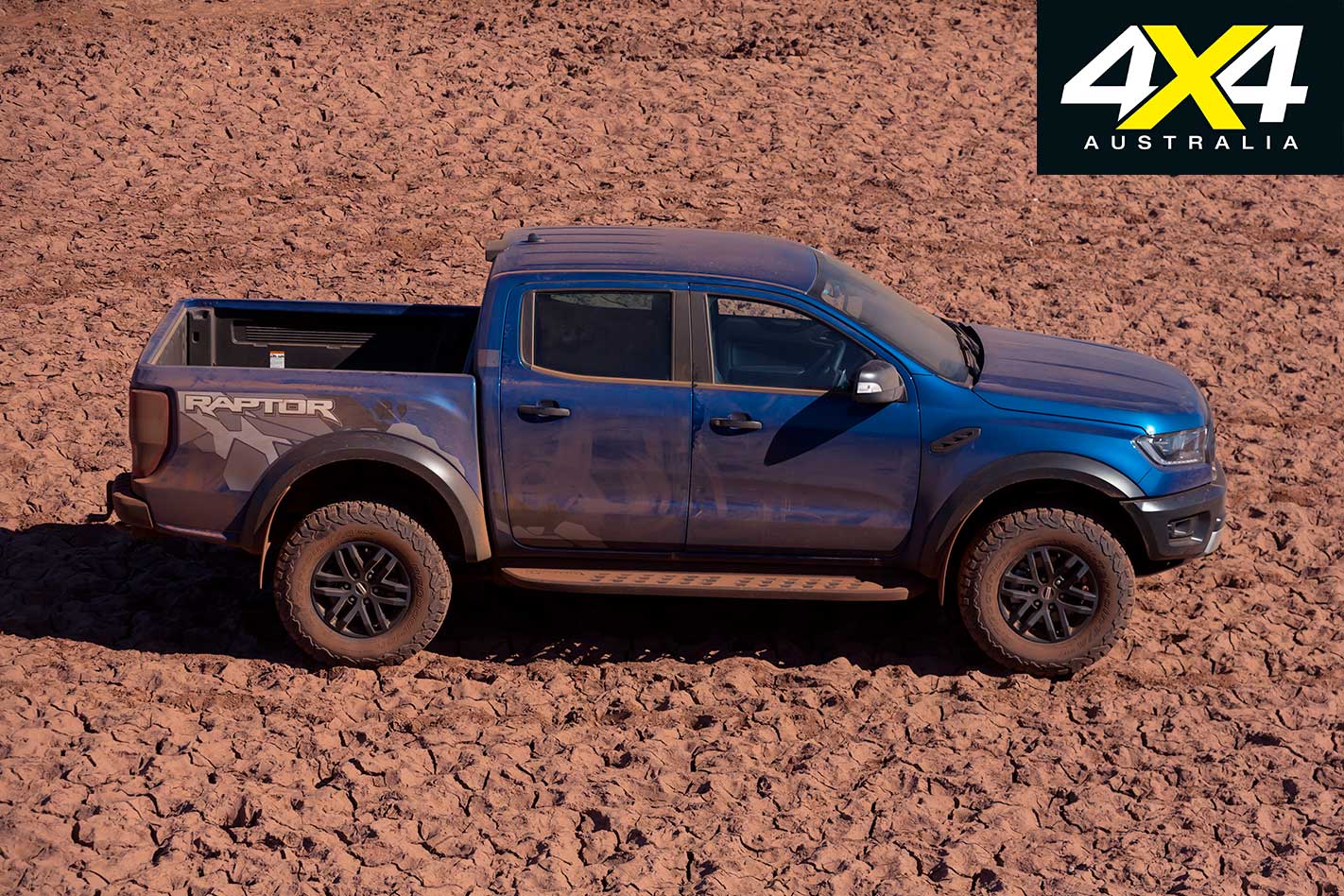
With the 2020 Ford Bronco coming off the T6 platform, as well as the existing Ranger and Everest, there will be at least three different wheelbases for this chassis and as many different rear suspension designs.
The rearmost part of the Raptor chassis also differs from Everest and Ranger in that it is modified to carry the bigger 285/70 spare BFG tyre, and the rearmost cross-member is an integrated tow bar with large recovery points at either end.
The Ford Performance Chassis Dynamics team worked closely with tyre manufacturer BFGoodrich to develop a specific version of its acclaimed KO2 All Terrain tyre for the Raptor.
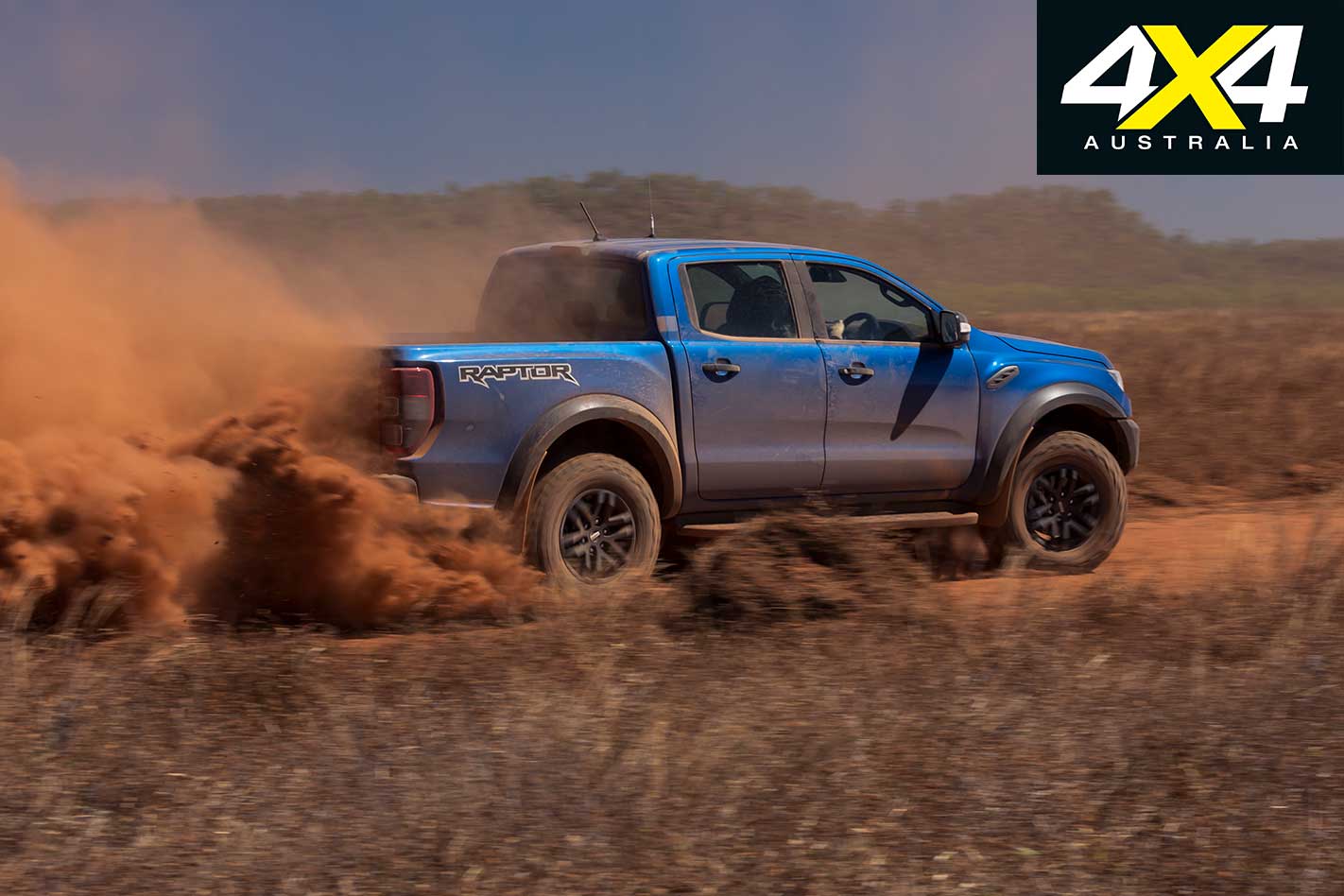
Engineers from both companies tested various tyre compounds and suspension settings to come up with a complementary package to achieve the desired traits. The LT285/70-R17 KO2 used on Raptor might look like any other BFG KO2, but it has a unique rubber compound and its own part number.
The bigger tyres and wider wheel track necessitated wider ’guards to cover them, and the Raptor has bulging front ’guards flanking either side of the signature black F-O-R-D Raptor grille. There’s also a unique slim-line bumper beneath it, dropping away to the underbody protection plates.
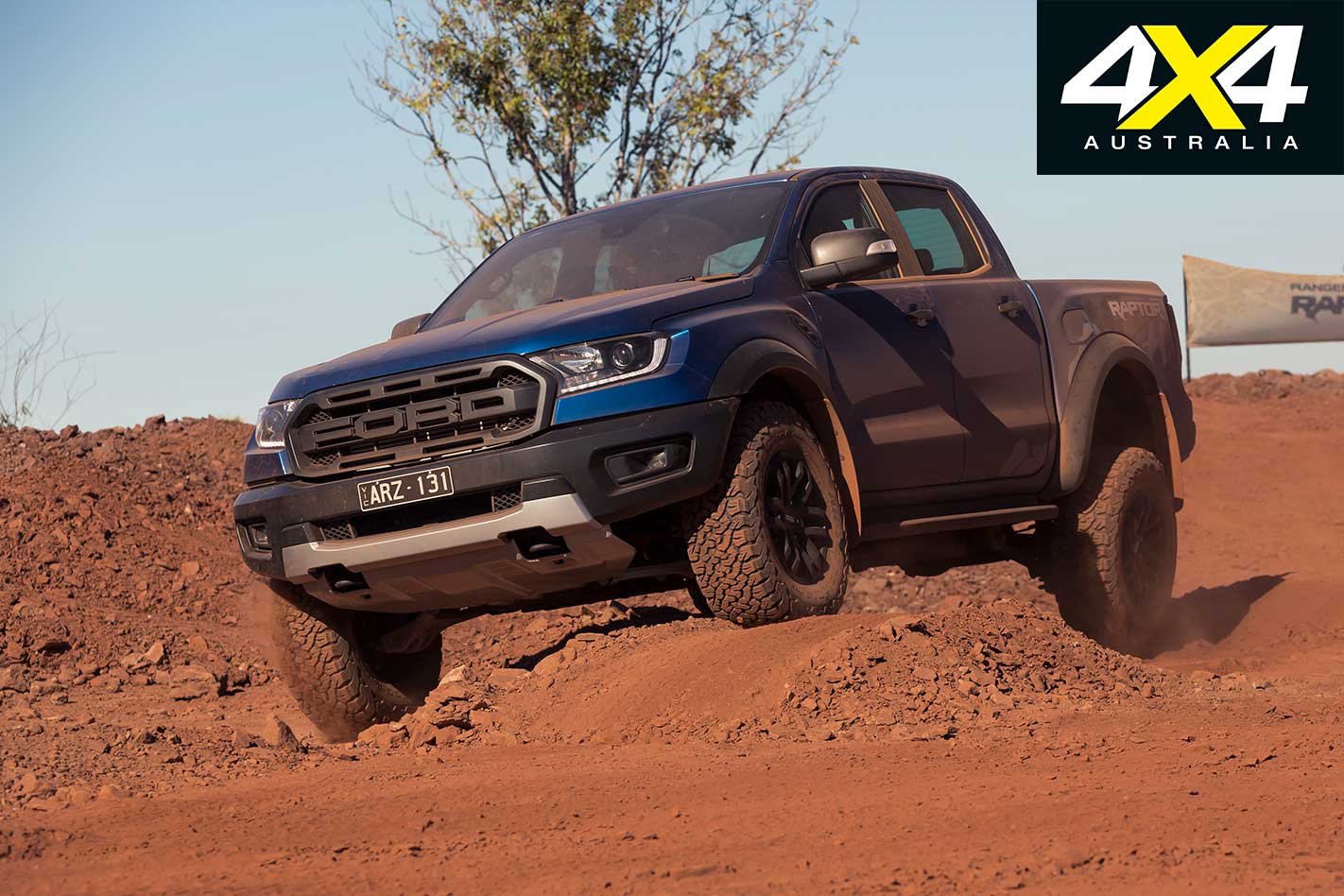
The front end is matched by a similarly bulging cargo box that, while externally wider, retains the same internal dimensions as a regular Ranger tub, meaning the existing tub liners, roller covers and other accessories will still fit this vehicle.
The bold, aggressive look of the Raptor reflects its built-for-purpose chassis and suspension package that are made to tame challenging tracks and terrain. What it doesn’t match is the Raptor’s powertrain which, let’s be honest, isn’t the highlight of the vehicle.
Don’t get us wrong, the new bi-turbo-diesel engine and 10-speed automatic transmission is a nice and refined combination, but it doesn’t live up to the Raptor’s aggressive good looks and potential.
The 2.0-litre, four-cylinder, bi-turbo-diesel engine makes 157kW at 3750rpm and 500Nm in between 1750 and 2000rpm, so it makes more grunt than the bigger five-cylinder diesel.
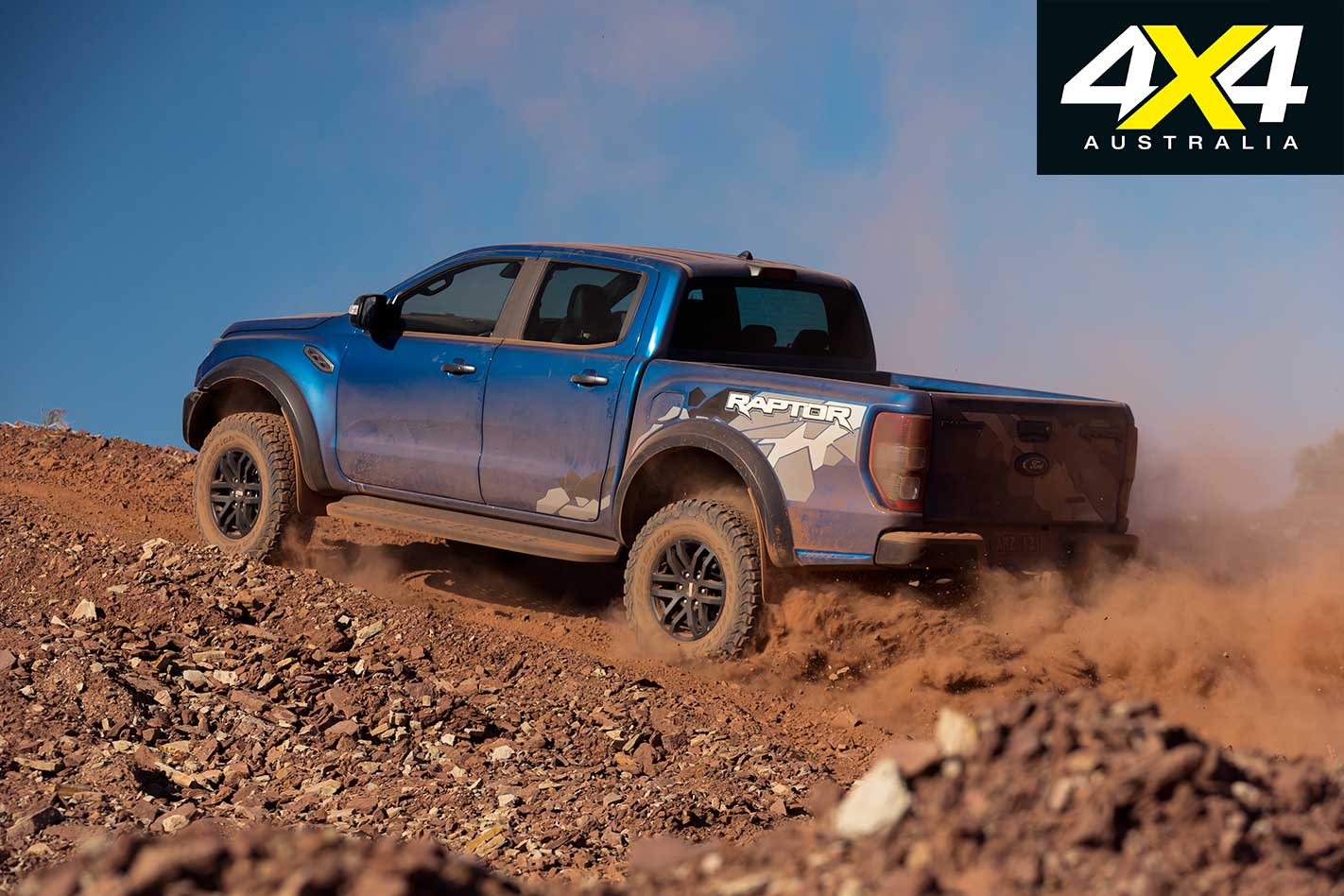
Despite being some 200kg heavier than a Ranger, the Raptor is around half a second quicker in the zero to 100km/h dash than a Ranger, and we verified that by putting it up against a Ranger Wildtrak, which was left behind by the Raptor as we matched Ford’s 10.5-second 0-100km/h claim.
But it doesn’t feel fast and, in reality, it’s not – this is still a diesel-fueled pick-up truck and not a road racer. The new engine and transmission combination, which will also find its way in to Ranger and Everest before year’s end, has more grunt and is quieter and more refined than the old 3.2-litre and six-speeder, but that refinement masks the modest performance on offer, which isn’t what many buyers will want from a monster truck like the Raptor.
Before you ask, no, there is no other engine currently planned for Australian-delivered Ranger Raptors in the foreseeable future … diesel, petrol or otherwise.
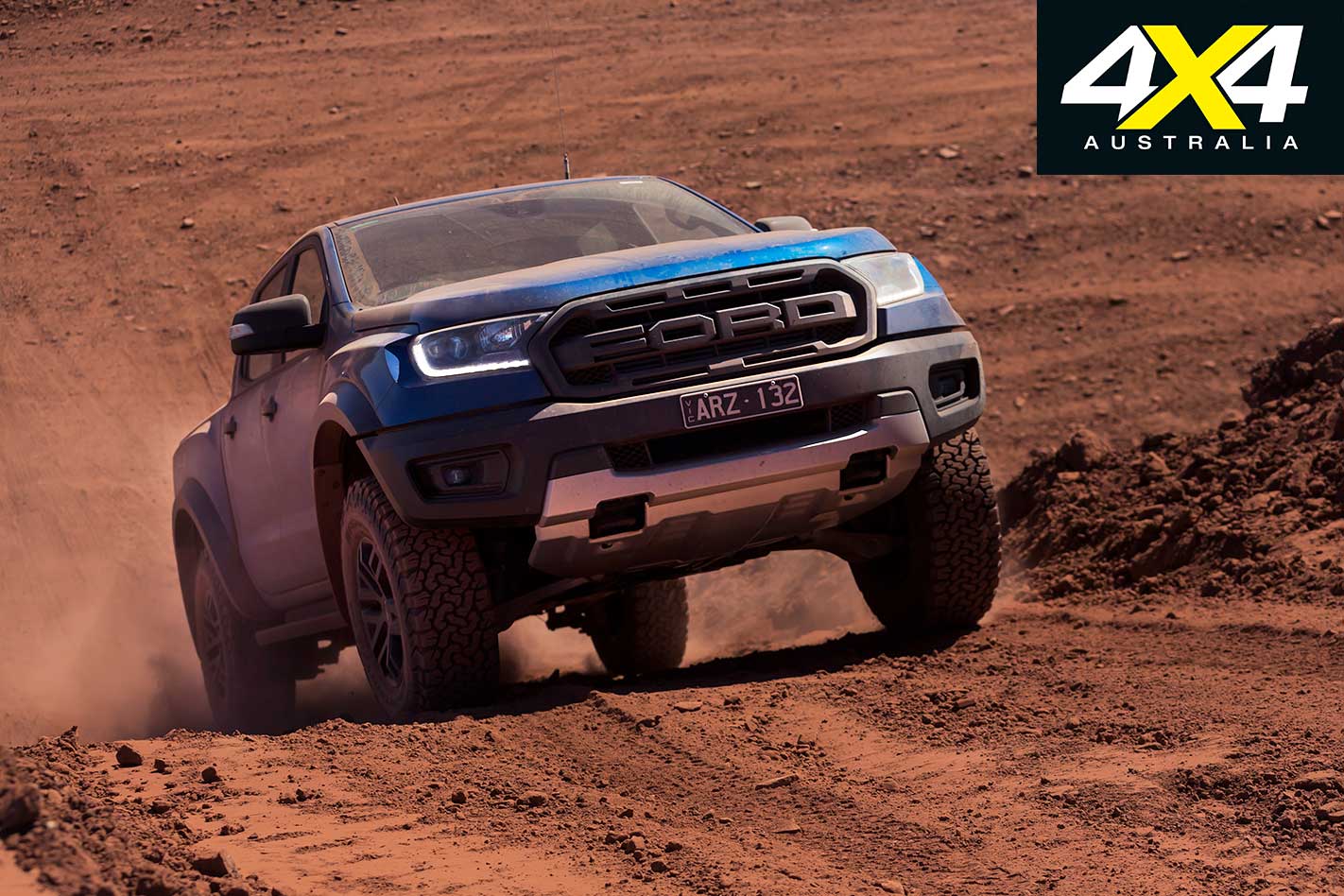
That begs the question: who is going to buy the $76,000 Ranger Raptor? With a reduced payload (700kg) and towing capacity (2500kg) the Raptor isn’t going to be on the shopping list of the touring 4WDer who is already battling with payloads and GVMs (3090kg). The unique front end will also limit what’s available in terms of frontal protection equipment, so outback touring in a Raptor presents new challenges.
Despite its pretenses the Raptor is not a racecar. It’s never going to take on something like the Finke Desert Race; although, it would form the nice basis for a safari-type racer. It would also be a fun ‘off-road Motorkhana’ type car. The Raptor is more like an HSV Commodore or FPV Falcon; it has the looks and improved performance to make it a fun vehicle to drive, but it’s not a serious racecar in standard form, nor is it meant to be.
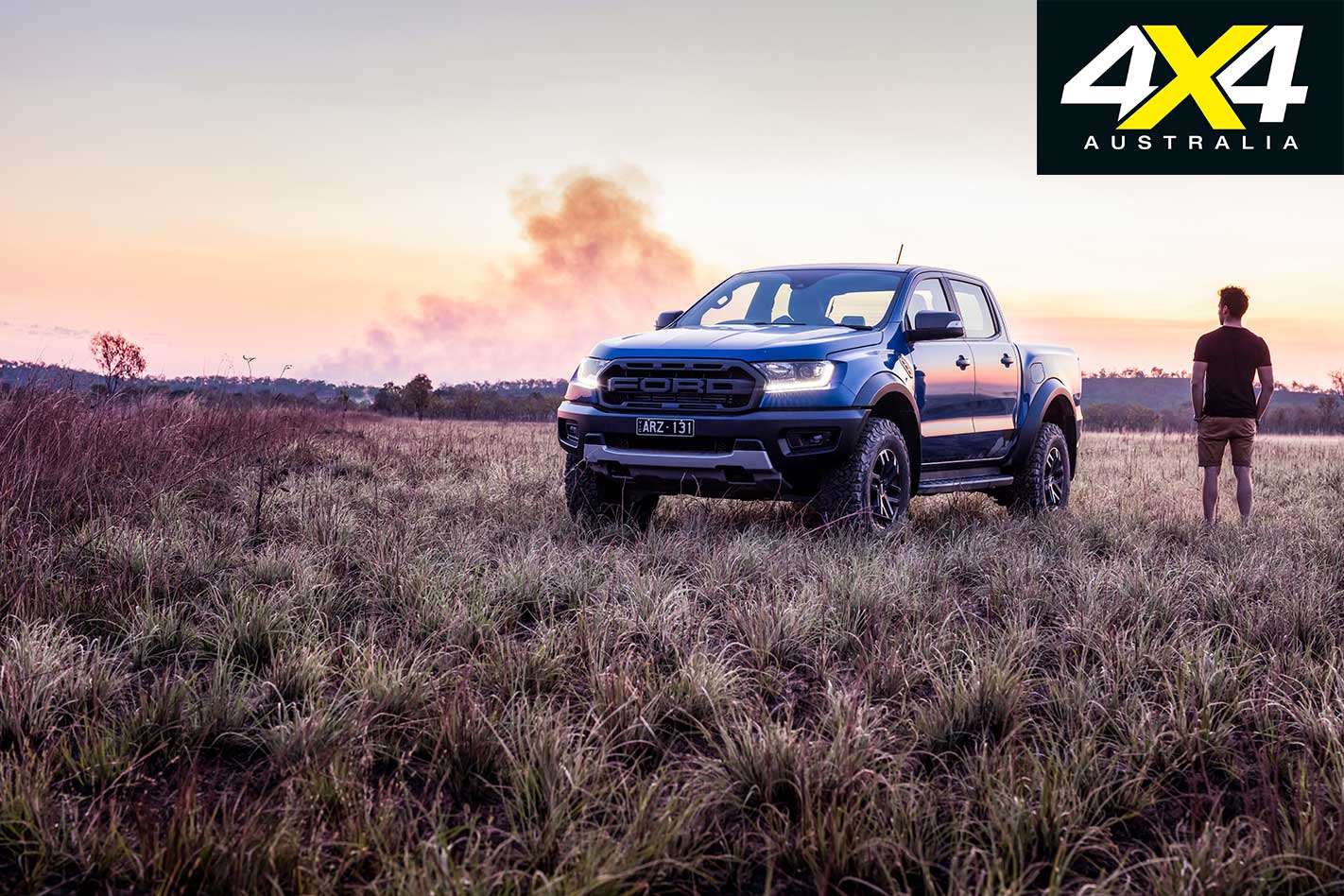
We reckon you’ll see a few Ranger Raptors getting around with a jet-ski or dirt bikes in tow, and couples who like to go weekend camping in something a bit more special than the regular work ute would also like the Raptor. Cruising down the beach or taking on 4×4 parks would also be on the list.
The market for the Raptor is limited, but that is always the case for a halo-type product. That said, the initial order of 1000 Raptors for 2018 has sold out and if you order one today you won’t get it until early next year, unless you can score a cancelled order. Those 2018 vehicles will be delivered during September and October this year.
The Drive
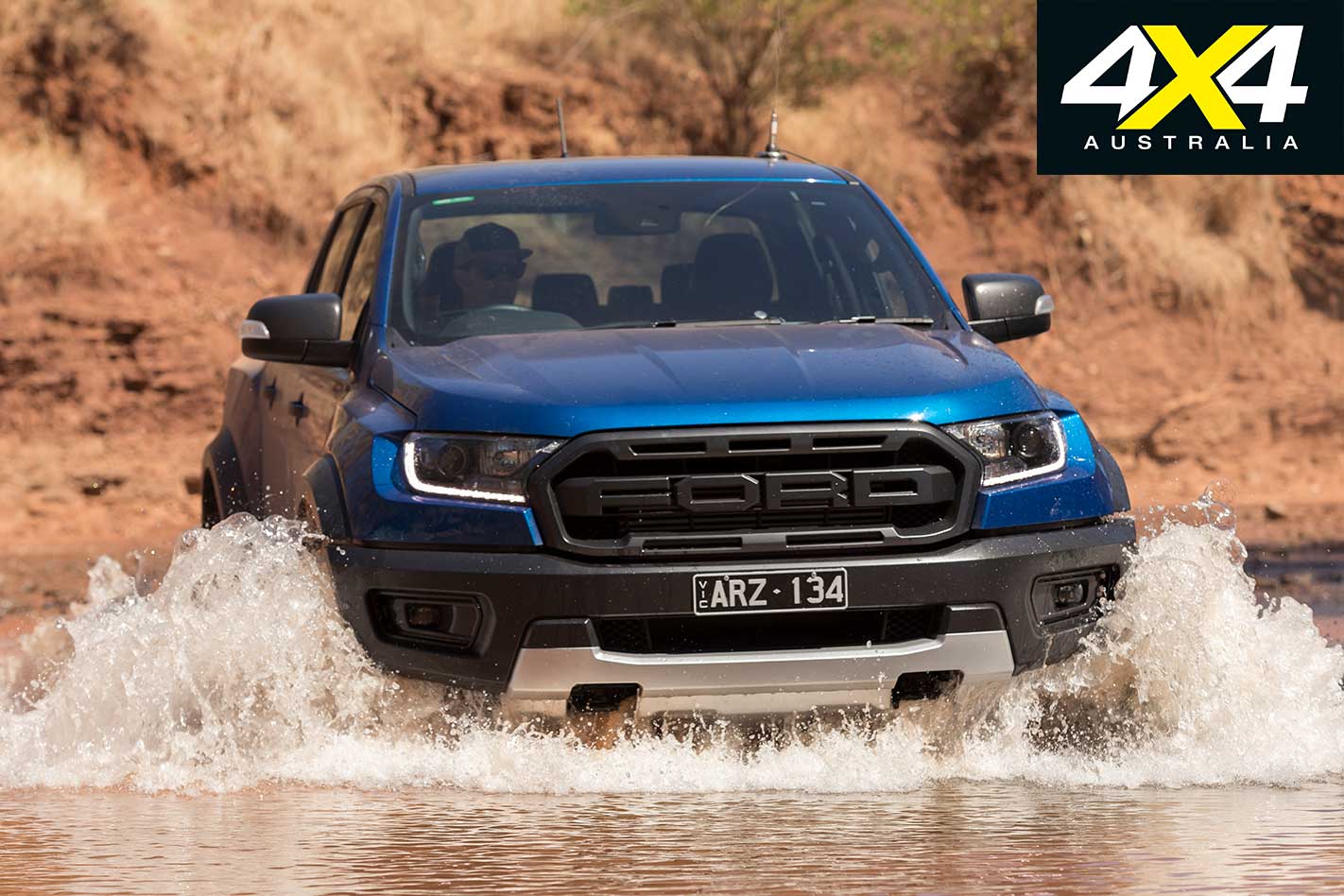
WITH its Ford Performance-engineered chassis and suspension package, the Ranger Raptor shows its best form travelling quickly over rough terrain. The outback test track Ford engineered to showcase it did that well, as it ate up whoops, bumps and bulldust like a Baja racer, instilling driver confidence and encouraging you to push harder.
The direction and stability offered by the BFGoodrich tyres in the heavy bulldust and loose rock was astounding. It goes where you point it and its slides are well-controlled, making the Raptor a lot of fun to drive.
The Baja mode in the Multi Terrain Selector frees up stability and traction control and sharpens up both the throttle response and shifting in the 10-speed auto, so it rewards the keen driver.
The Fox suspension smooths out bumps and washouts, allowing you to take them at speeds you could never handle with conventional OE suspension. Again, this instills confidence and allows you to wind up the fun dial to maximum.
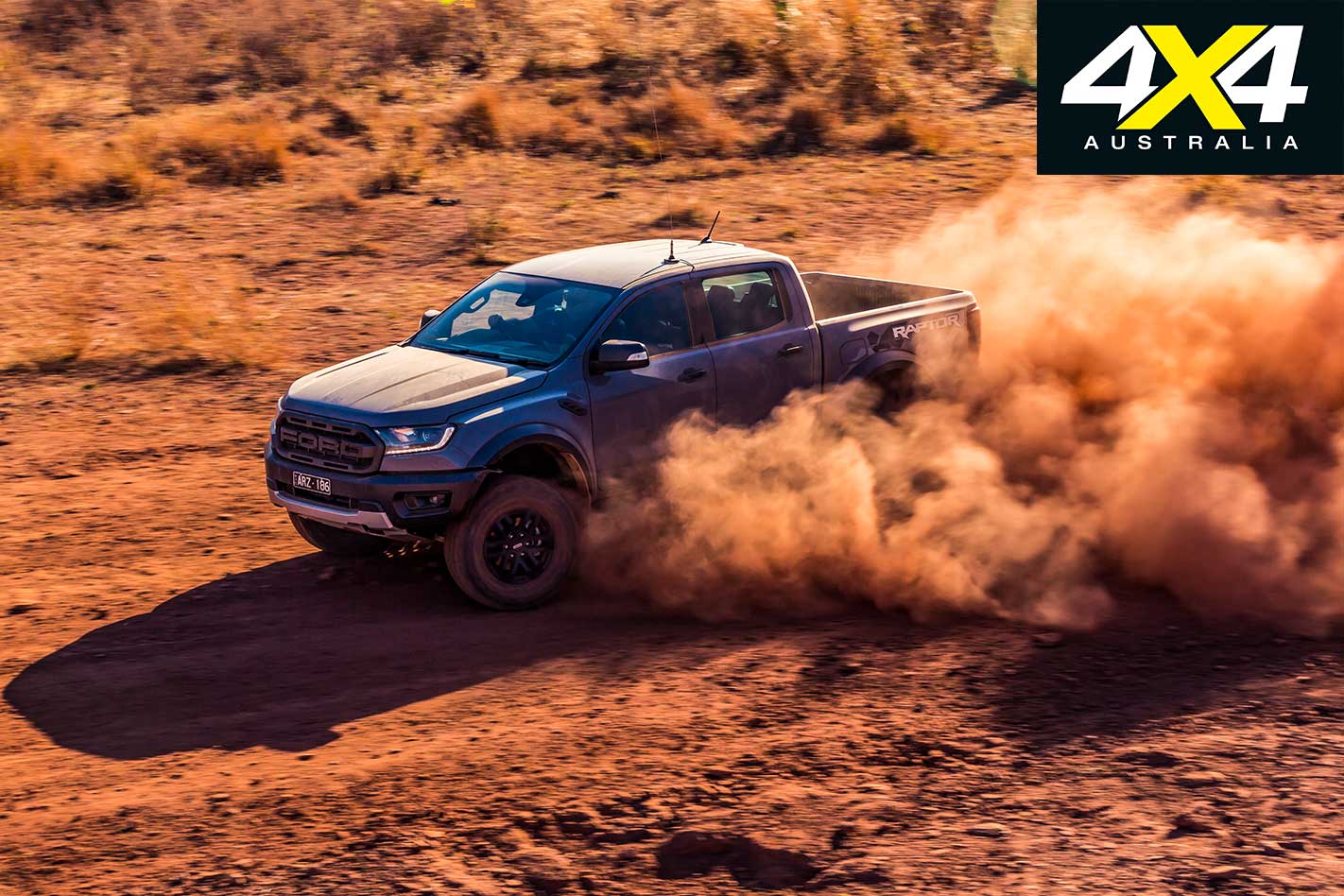
However, fanging around a test track isn’t something anyone does too often, and the Raptor’s amazing chassis package delivers on rough roads as well.
The chassis is well-controlled over rough ground, again giving confidence in the vehicle and knowing that it is capable of taking on the terrain. It also makes the ride more comfortable, so driving long distances in a Raptor will keep a driver relaxed and more on the ball. Knowing the All-Terrain tyres are less prone to puncture than regular passenger car tyres typically found on OE cars is also reassuring.
On the highway and backroads, that same suspension delivers a softer and more compliant ride than the leaf springs on any other ute. The refinement of the engine and transmission also contributes to improved on-road driving, and the truck-like rattle of the old 3.2-litre engine is gone due in part to the smooth and swift 10-speed auto. The Raptor is the most un-truck-like truck on the market!
It’s only when overtaking at highways speeds (130km/h here in the Territory) that the engine is found wanting, as it doesn’t pull like you want it to and the acceleration is not what you expect from a vehicle built under the Ford Performance banner.
Second opinion: 4×4 Australia road trip feature review
We took our 4x4OTY-winning Ranger Raptor to the hills, to see how it performs in the steep stuff. By: Matt Raudonikis | Photos: Alastair Brook
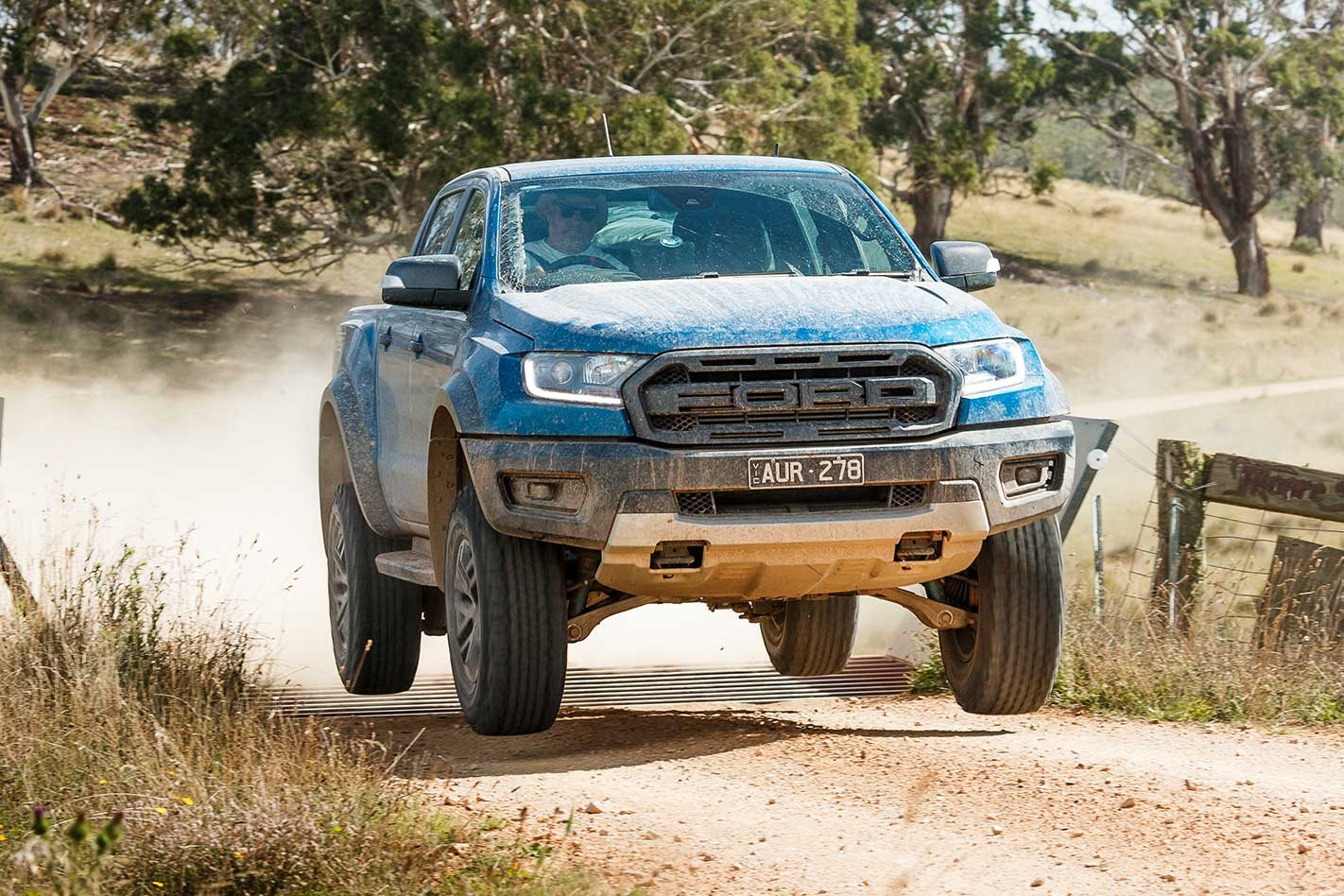
A LOT has been said about Ford Australia’s 2019 Ford Ranger Raptor, much of it negative about the 2.0-litre diesel engine and reduced load and towing capacity, but plenty of positives regarding its amazing suspension, off-road performance, and improved ride and handling.
We weighed up the positives against the negatives and gave the Raptor our 4×4 of the Year accolade, and that was as good an excuse as any to take it out for another run.
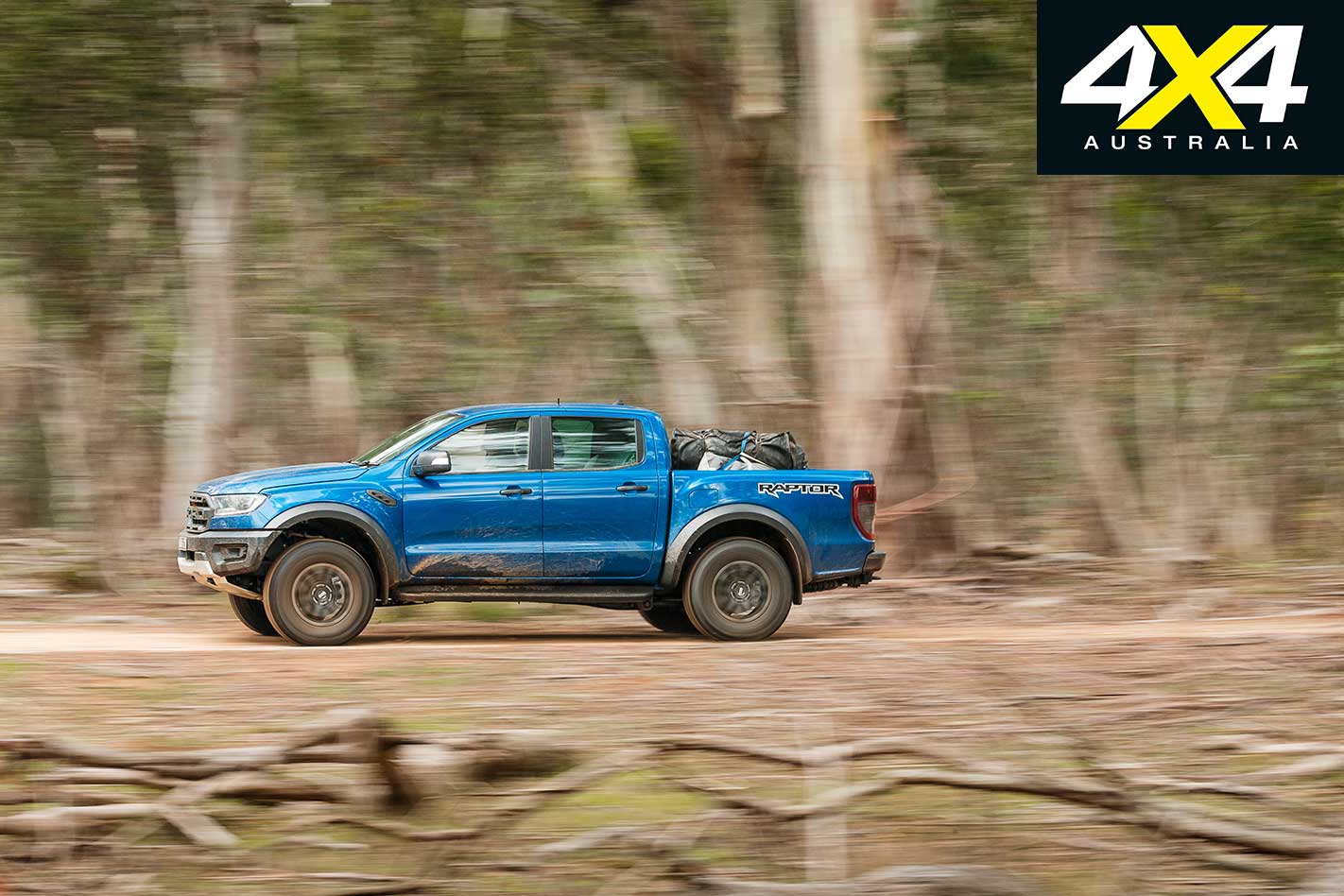
Most of the positive talk about the Raptor centres on its desert racing-bred Fox Racing suspension and high-speed ability over rough terrain, but we wanted to test it in the hills doing lower speed off-road driving on steep terrain. More like the stuff many Aussies enjoy in places like the Victorian High Country.
The Ranger Raptor’s off-road credentials are impressive. It sits 50mm taller than a regular Ranger, resulting in a wading depth of 850mm and ground clearance of 283mm. Approach, rampover and departure figures measure 32.5-, 24-, and 24-degress respectively, to further improve clearance, while sturdy underbody protection and beefy magnesium side-steps shield from the inevitable bumps and grinds.
The Raptor rides on a wheel track which is 150mm wider than that of a regular PX Ranger, to give it a wider stance and improved stability. To achieve the extra width, bespoke aluminium A-arms are used on the independent front suspension; while at the rear the leaf-sprung live axle of the regular Ranger is replaced by coil springs with a Watts linkage for lateral support, derived from that on the Ford Everest wagon.
It differs from the Everest rear end in that the remote-canister Fox coil-over dampers are mounted farther outboard, again to improve vehicle stability and control. The revised rear axle even has disc brakes as opposed to a Ranger’s drum stoppers. The suspension changes result in a 32 per cent improvement in front-end travel (to 236mm in total) and a 22 per cent improvement at the rear (to 290mm in total).
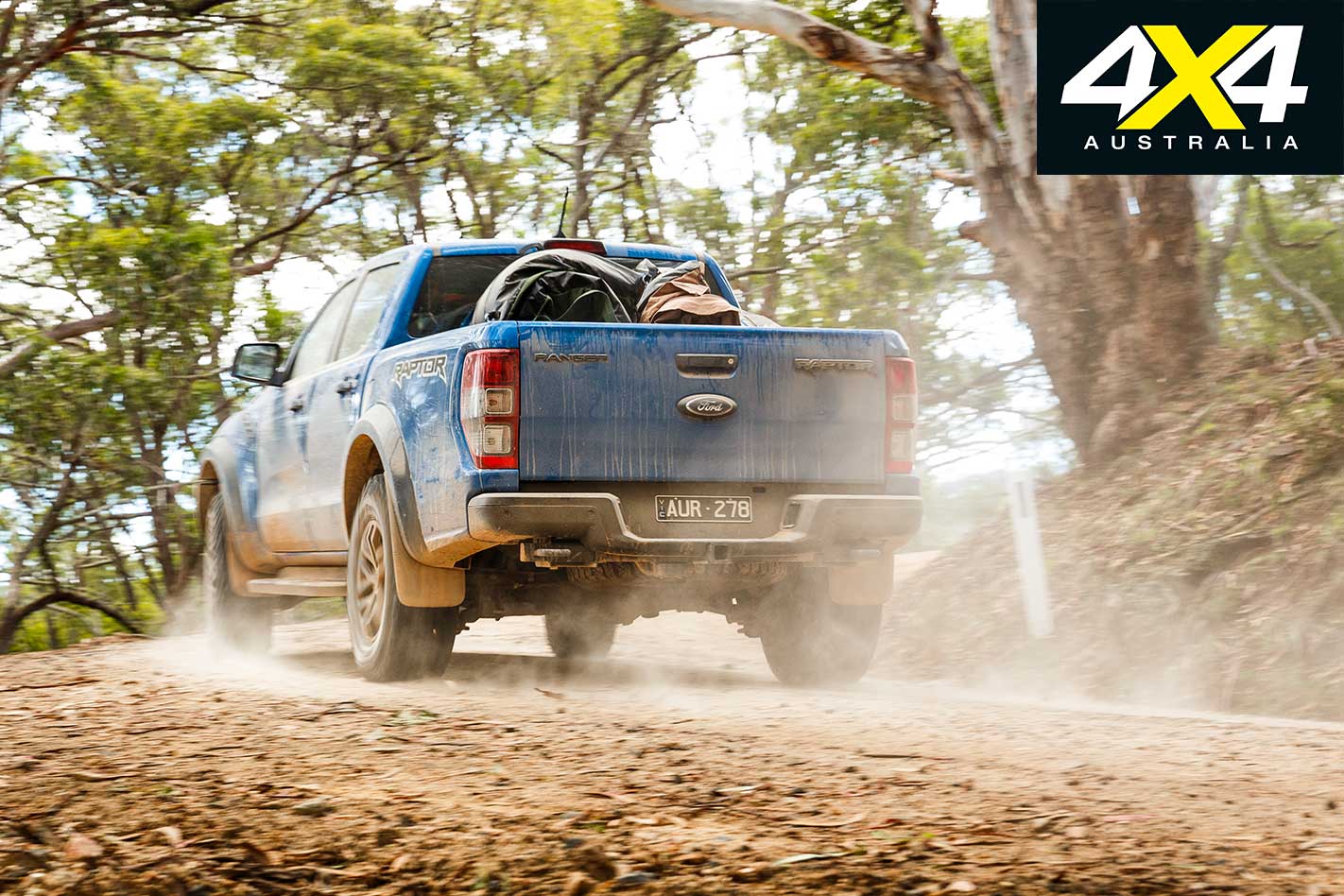
The Fox coil-overs used at the front and rear are specifically designed 2.5-inch twin-tube units, which were a collaboration between Fox Racing, Ford Performance and the Ford Australia engineers who put the package together.
Likewise, the BFGoodrich All Terrain KO2 tyres are a specific tyre bred for this vehicle by BFG and Ford. They might look like a regular 285/70-17 KO2, but they utilise a unique rubber compound and have an ‘F’ in the part number to mark this difference.
When you consider quality suspension and tougher tyres are the first things to fit when equipping a 4×4 for off-road use, Ford Performance has you covered with the Raptor. All of this top-shelf hardware, development and engineering add up to an off-road package that is superior to any other one-tonne 4×4 ute off the showroom floor, and it performs better than most aftermarket setups as well.
Off-Road
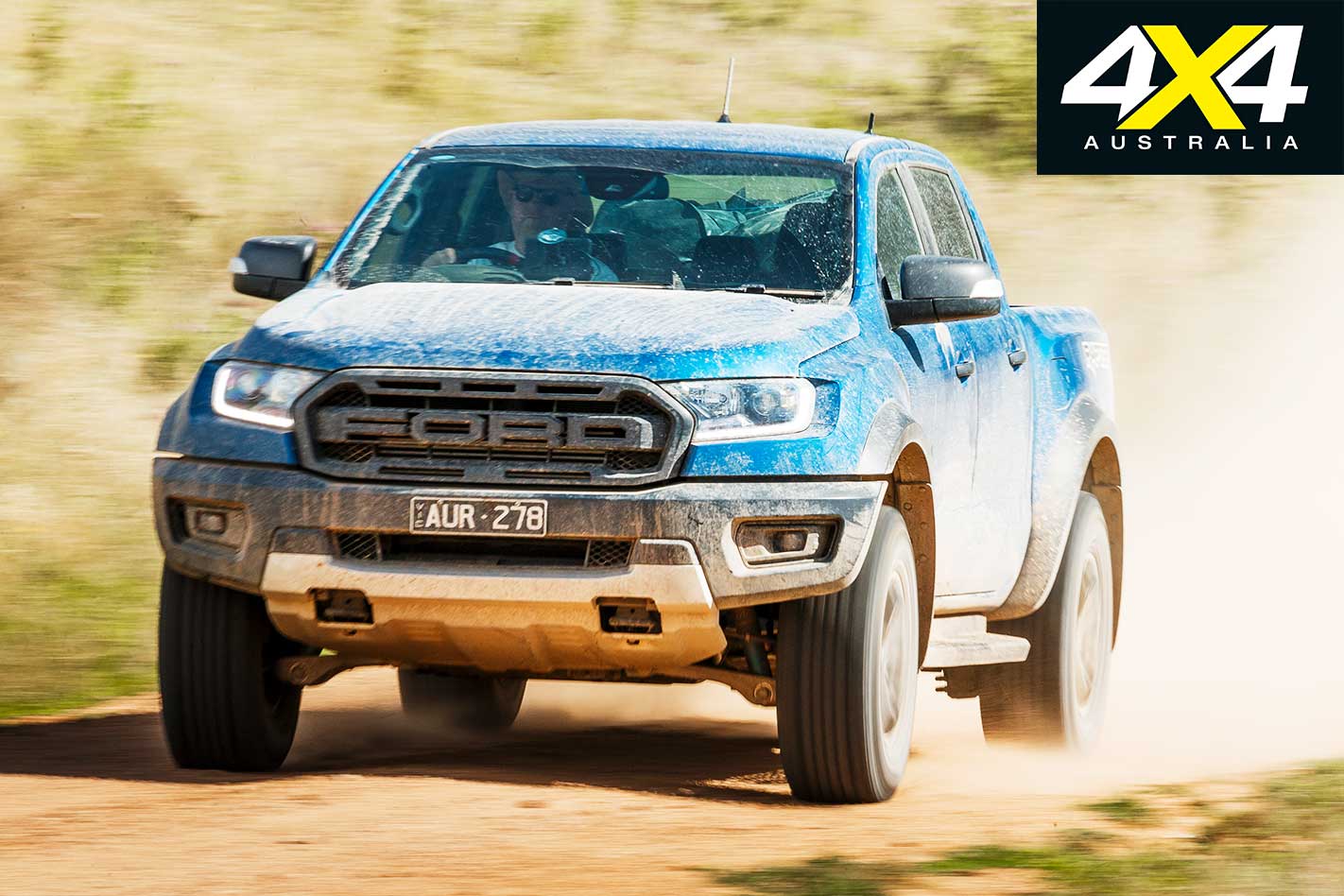
WE’VE tested the Ranger Raptor in the outback a few times already, but we wanted to see what it’s like in the mountain regions of the east coast. For this, we ventured further than our regular Vic High Country haunts to explore the hinterland behind the far south coast of New South Wales, where we found plenty of steep and slippery tracks.
Just as the wheel travel and ground clearance offered by the Raptor’s suspension package work well at speed in the outback, they are also the key to slow-speed track performance over rocky steps and fallen logs.
The extended wheel travel keeps the BFG tyres in touch with the track surface to maintain traction, which means the Raptor relies less on its electronic traction control and rear differential lock; but they are still very handy if and when needed.
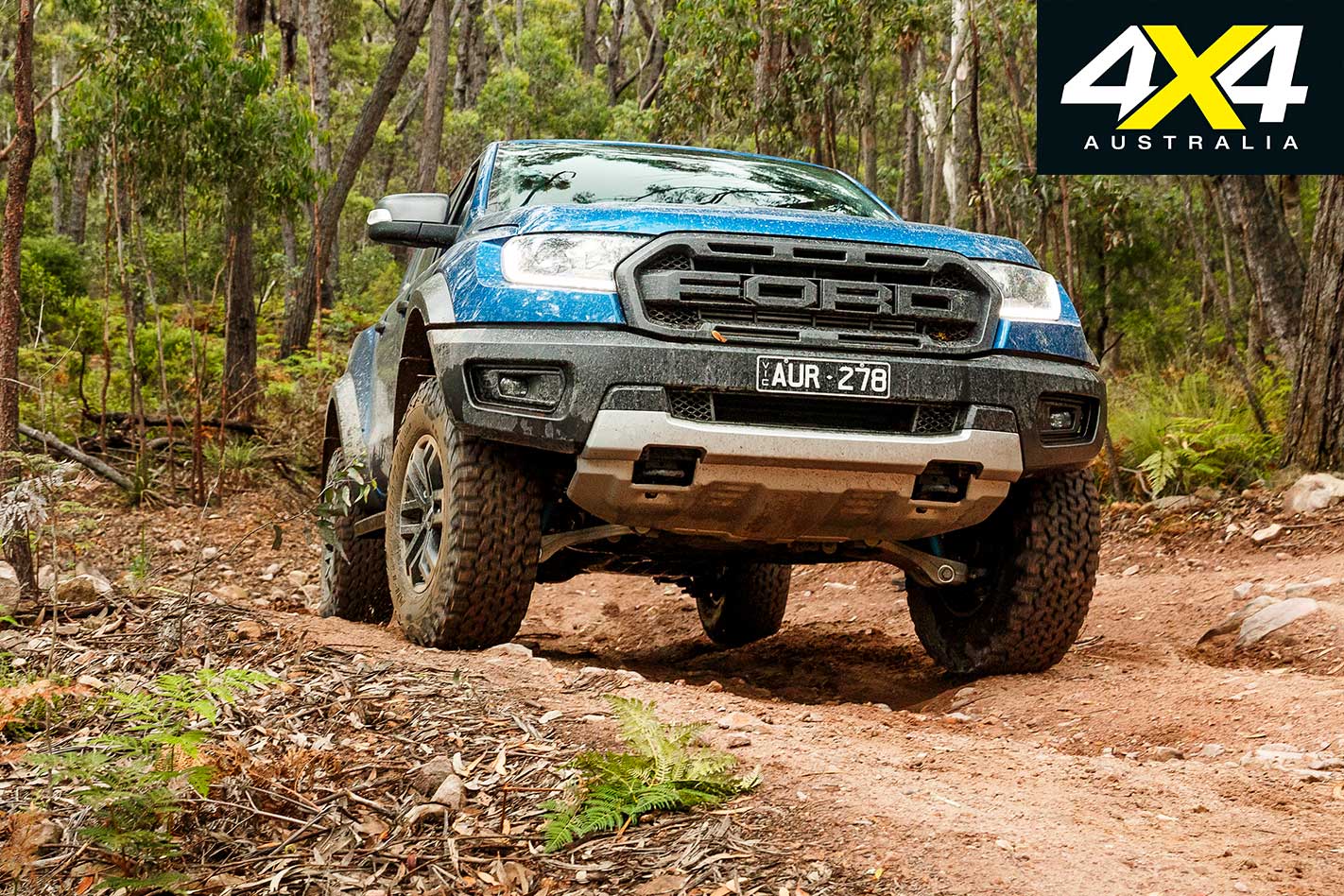
The Raptor is still a proper 4×4 with a dual-range transfer case, so making the steep climbs and descents in low range was never an issue. However, the 10-speed auto transmission was overly keen to shift back when descending and it was sometimes confused in low range; it worked better when in manual mode, using the steering wheel-mounted paddles.
The performance of the 2.0-litre bi-turbo diesel engine might feel wanting for flat-out, high-speed blasting, but its 500Nm provides plenty of grunt for low-range hill-climbing and trail driving. The 10-speeder works well here, too, whether you choose to let it do its own magic or shift it manually.
The more refined drivetrain (over the 3.2-litre and six-speed), more supple suspension and luxury cabin features also work to make the Raptor a more comfortable touring vehicle. You feel the softness of the suspension every time you drive it on any surface, and there’s none of that harsh, jittery ride that comes with most leaf-sprung 4×4 utes. The Raptor’s front seats are real winners, adding comfort to the drive and making long days behind the wheel a pleasure.

Adding to the ease of touring, the internal dimensions of the cargo tub are the same as a regular Raptor, so accessories such as tub racks, hard lids, tonneau covers and canopies will still fit. For this trip we utilised the four tie-down hooks to secure our gear, and the in-tub 12-volt outlet to power an ARB Elements fridge.
Many ute buyers dislike the Ranger Raptor’s reduced carrying capacity compared to a regular Ranger: the towing capacity is cut from 3500kg to 2500kg; while payload weight is 758kg, down from 900kg of a Ranger XLT. We didn’t do any towing on this trip, but we did test the payload to its limits on the return highway drive.
Loaded up with three blokes, all their camping gear, a 50-litre stainless steel ARB fridge and a Space Case full of supplies, the rear end felt the extra weight. While it wasn’t bottoming out, the suspension felt spongy and towards the end of its compression on the winding and often bumpy roads. You certainly wouldn’t want to be off-roading a Raptor with this sort of a load onboard. Buyers will have to settle for a regular Ranger for heavy towing and hauling duties.
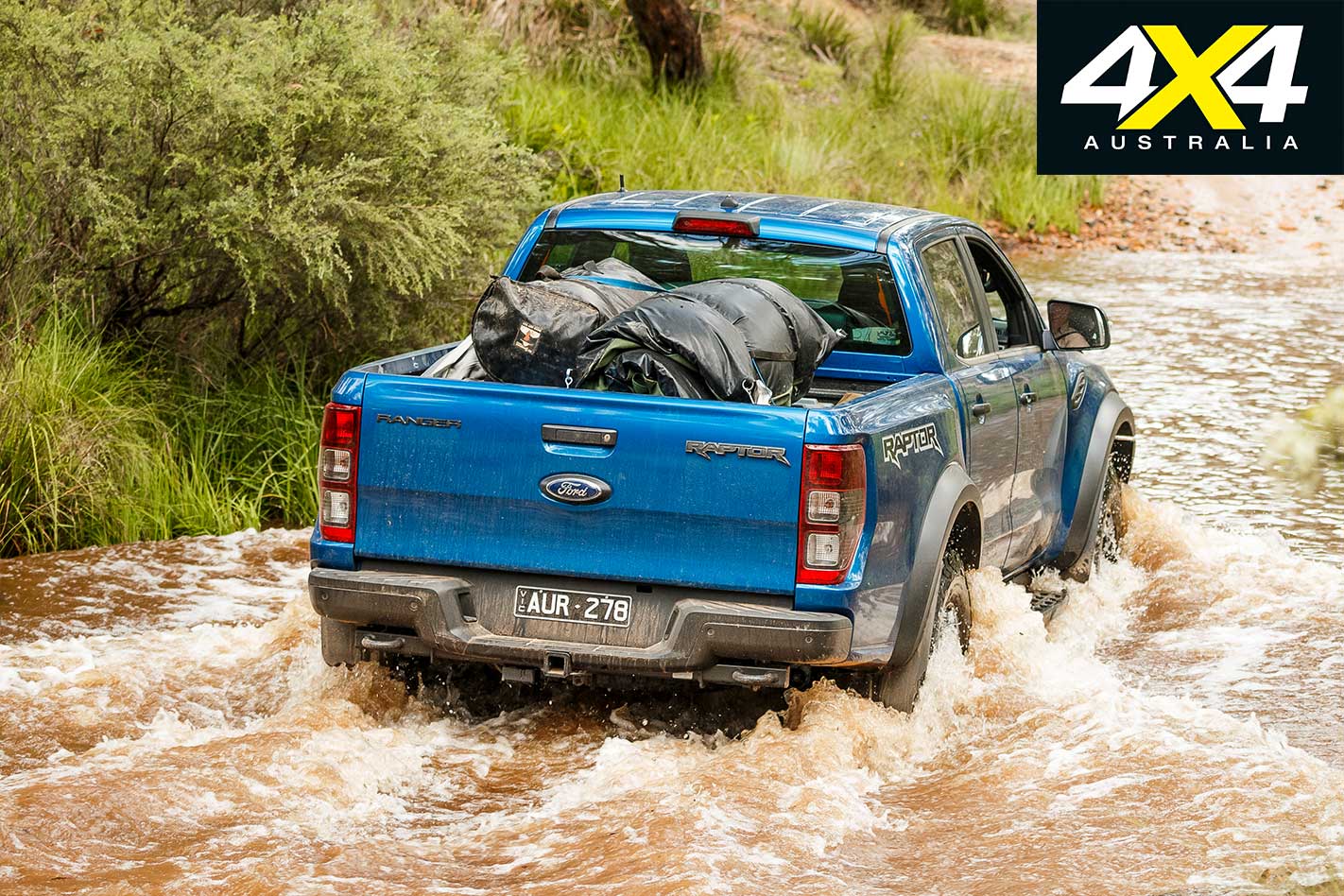
So the Ranger Raptor has proven itself to be just as competent as a mountain-trail tourer as it is a desert-track blaster. If the lower payload and towing capacity of the Raptor over a regular Ranger aren’t a concern, then the Raptor makes a great starting point for a long-distance traveller.
Before you complain about the cost of the Raptor, the $11K it costs over a Ranger XLT 2.0L wouldn’t even cover the costs of the bespoke wheels, tyres and suspension package, even if you could buy them separately. Then there’s the updated interior kit and that killer wide-body design that turns heads wherever you drive it, which make the Raptor a unique proposition.
2019 FORD RANGER RAPTOR SPECS: Engine: 2.0-litre 4-cyl bi-turbo diesel Max power: 157kW at 3750rpm Max torque: 500Nm at 1750-2000rpm Transmission: 10-speed auto 4×4 system: Dual-range part-time Kerb weight: 2332kg GVM: 3090kg Payload: 758kg Towing capacity: 2500kg GCM: 5350kg Wheel/Tyre: LT285/70R17 116/113S Fuel tank capacity: 80 litres ADR fuel consumption: 8.2L/100km Test fuel consumption: 12.7L/100km Price: $74,990 (as tested with ORC)


